Last updated on April 30, 2024
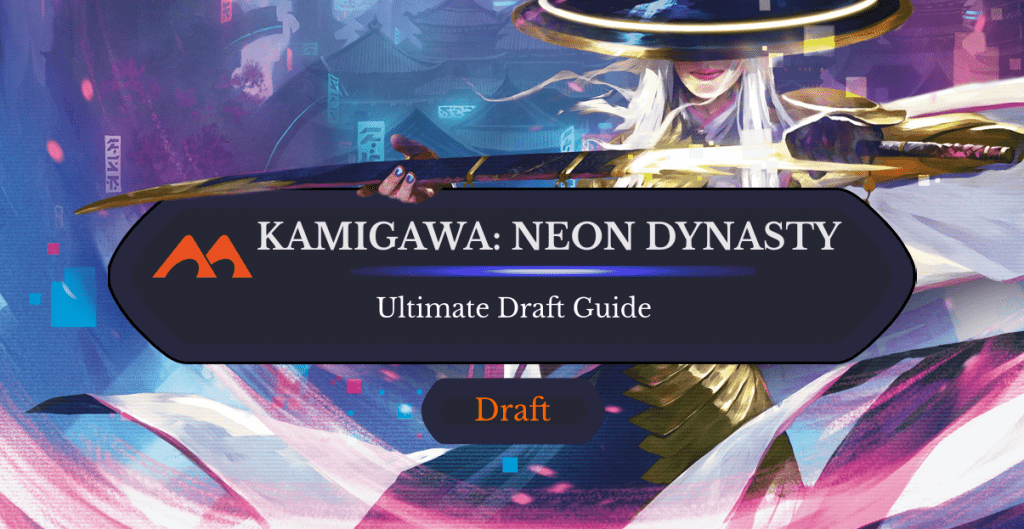
Neon Dynasty art by Dominik Mayer
Wake the Flumph up samurai, we’ve got a new format to learn. Neon Dynasty has rave reviews by limited grinders on social media and plenty of relevant Limited tournaments to play, including a Sealed/Draft Open this weekend.
I think it’s high time for another ultimate draft guide!
Mechanics
Check out our Limited NEO set review for the basics of each mechanic. I’ll be examining each one in a bit more detail to help introduce you to important concepts in the set.
Reconfigure
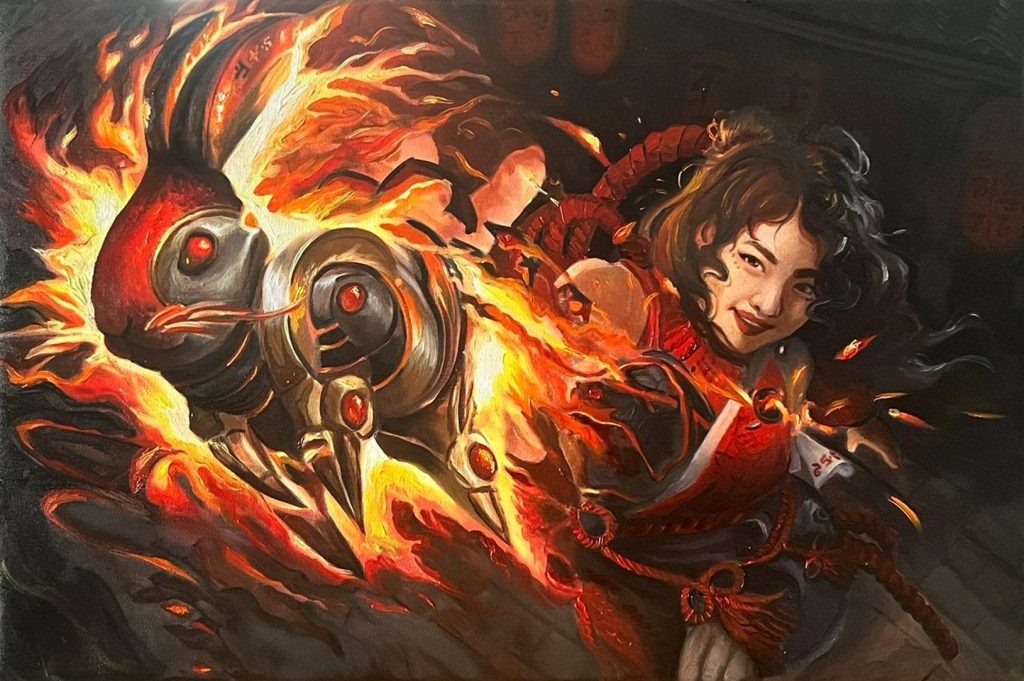
Rabbit Battery | Illustration by Justyna Gil
Reconfigure is a new mechanic introduced in the set that shows up on 14 artifact creatures. Each color has at least one creature with reconfigure but it primarily appears in blue, black, and red.
Creatures with reconfigure are unique in that they function as both creatures and equipment, but they always enter the battlefield as creatures. This mechanic adds a lot of flexibility and scalability to what would otherwise be underwhelming vanilla creatures. Evaluating a card with reconfigure (let’s use Acquisition Octopus as an example) should look something like this:

Base creature rate: The Octopus is identical to Stealer of Secrets with the added upside/downside of an artifact subtype. It’s a generally solid Limited playable that wants to be paired with removal, bounce, and freeze spells or ways to give evasion. It’s defensively weak.
Base equipment rate: It’s Rogue's Glove, but it costs instead of . Great when combined with small fliers or evasive creatures but weak when you’re behind.
Combined conclusion: Being a Rogue's Gloves/Stealer of Secrets hybrid without having to overpay for either makes Acquisition Octopus a great uncommon for almost any deck. Two cards a turn is a game-winning setup, and the Octopus gives you two realistic paths to get there if it sticks around. The only exception is very creature-light decks that lack good creature interaction to connect with it.
Modified
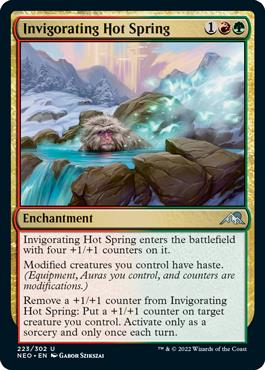
Modified is another new mechanic. It references a creature that’s “enchanted, equipped, or has a counter on it” (that counter does not have to be a +1/+1 counter, which is relevant with cards like Biting-Palm Ninja). Any creature that meets this description counts as a modified creature for any spells or abilities that care about it. Modified is present on 17 cards, mostly in red in green and not at all in white. This is the core draft mechanic for Gruul () decks as showcased in its signpost uncommon, Invigorating Hot Spring.
The main reason to care about modification are the 17 cards that care about it since many of them, like Unforgiving One and Walking Skyscraper, are dramatically more effective if you can set up two or three modified creatures for them. There are several ways to pull this off in Neon Dynasty that vary when it comes to their convenience and practicality. While I’ll cover this more below in my section on the Gruul Modified archetype, here’s a brief crash course:
Equipment
Reconfigure being in the set increases the number of playable equipment available. Every single creature with reconfigure is at least a filler-level playable, though cheap 1- to 2-mana reconfigure work better than expensive 4-mana ones. Ninja's Kunai, Eater of Virtue and Ancestral Katana are playable ways to get modified from equipment outside of reconfigure.
Auras
Auras are risky as always since they expose you to a 2-for-1 if the creature wearing it is answered. Any aura you play should be powerful enough to justify this, or at least mitigate the risk in some way.
Akki War Paint and Gift of Wrath are classic noob trap auras with risk levels that don’t match their usual reward, so I generally wouldn’t recommend either. On the other hand, Careful Cultivation and Favor of Jukai give you the same functionality but also double as a mana dork/combat trick which makes them safer inclusions. Twisted Embrace is an awesome way to get modified from your removal slot if you’re playing black.
The two land auras, Crackling Emergence and Harmonious Emergence, deserve special mention for their convenient interaction with modified. While this might not be immediately intuitive, creating a land creature by equipping an aura to a land adds a modified creature to your board. You can roughly evaluate these cards like this:
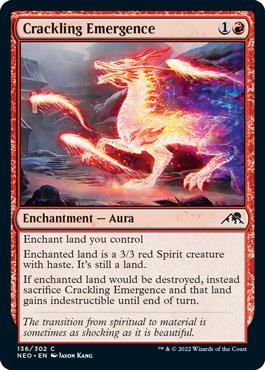
Crackling Emergence: for a 3/3 that enters tapped, or for a 3/3 haste, plus some awkwardness for having to choose between using it as an attacker, blocker, or mana source.

Harmonious Emergence: for a 4/5 that enters tapped, or for a 4/5 with vigilance and haste, plus it’s slightly less awkwardness since vigilance lets you attack with it and then use it for mana or block with it.
Neither card should really blow you away, but they make for solid playables in aggressive decks that care about modifying creatures. Just be careful against Moonsnare Specialist and Tamiyo's Compleation, both of which excel against these.
Counters
The easiest (and arguably the best) way to modify your creatures is through the use of +1/+1 counters. Creatures like Jukai Preserver and Seven-Tail Mentor are playable on their own while also being great for modification. There are incidental counters on a lot of combat tricks and pieces of interaction as well, like Essence Capture, Explosive Entry, and Light the Way.
There are also a handful of cards in the set that enter the battlefield with keyword counters. These are Kappa Tech-Wrecker, Invoke the Ancients, and Biting-Palm Ninja, all of which are excellent cards. They’re exceedingly convenient sources of modified if you’re lucky enough to have them!
The only other card I’d mention is Reckoner Bankbuster, a powerful rare vehicle that counts as modified if you crew it thanks to its charge counters.
Sagas
Sagas are a returning mechanic that first appeared in Dominaria, but they come to Neon Dynasty with a big twist. All of the 23 sagas in the set are double-faced cards that re-enter the battlefield as creatures on Chapter III!
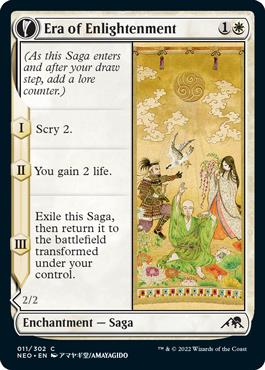

This has a lot of gameplay implications and can make them tricky to evaluate as cards. To ease you into the right mindset, take a look at Era of Enlightenment. Is this a very efficient 2-drop? Is it too slow to be playable? Somewhere in between?
The easiest way to evaluate the Era is to understand that it’s scry 2 now, two life later, and then a creature after that. And then after that the creature can finally attack. So you can’t put Era of Enlightenment in my deck expecting it to pressure my opponent much since it’ll likely be outsized by turn 5 when it’s able to attack. But it’s useful as a value card to smooth out your opener with scry 2 and later turn into a 2/2 with first strike.
Though there are a lot of sagas in the set that are better than Era of Enlightenment, most of them play well as value cards in midrange and control decks and so-so in aggro strategies. Exceptions to this rule include Befriending the Moths, Michiko's Reign of Truth, Okiba Reckoner Raid, Kumano Faces Kakkazan, The Shattered States Era, and Tales of Master Seshiro, which all function well in aggressive decks.
Ninjutsu
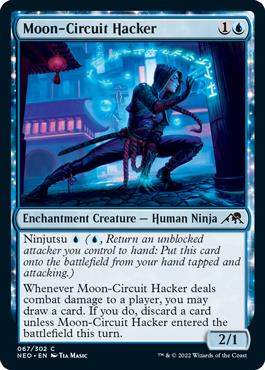
Ninjutsu is a returning fan-favorite mechanic with its first appearance in MTG dating all the way back to Betrayers of Kamigawa. A creature with ninjutsu can be exchanged with an unblocked attacking creature and put directly into play from your hand. It’s the core draft mechanic for Dimir () that appears on 17 creatures in every color but red.
This is a mechanic that’s both simple and complex. The simplicity comes from the basic play pattern: small evasive creature plus any ninjutsu creature, while the complexity stems from post-damage step shenanigans, multiple ninjutsu activations in the same turn, etc. Let’s start with a simple rundown of how the mechanic plays out in practice to properly frame its place in this set.
Enablers
There are two kinds of good enablers for ninjutsu: cheap evasive creatures, and cheap value creatures. Network Disruptor and Mothrider Patrol are examples of the former, while Virus Beetle and Spirited Companion represent the later. Evasion helps reach more easily your opponent while cheap enter-the-battlefield abilities punish them for letting an otherwise weak creature connect. An unblocked 1/1 can make way for…
Ninjas
… a variety of powerful ninjas! These range in effect from value plays like Moon-Circuit Hacker and Moonsnare Specialist to more powerful beaters like Dokuchi Shadow-Walker that can surprise your opponent with a sudden burst of damage. Most ninjas are cheaper when put into play via their ninjutsu ability but there are exceptions to this rule, like Thousand-Faced Shadow and Nashi, Moon Sage's Scion.
Advanced Ninjutsu
It’s worth covering in a bit of detail what else you can do with this mechanic besides the basic A -> B play pattern, and how to play against it. Understand that you have the option to ninjutsu an unblocked creature at any point after the declare blockers step all the way up to the end of combat step. This means that I can hit you with my Kappa Tech-Wrecker, remove its deathtouch counter to exile something, and then ninjutsu it into my hand during the damage step after damage has been dealt. This interaction is particularly powerful with Moonsnare Specialist since it’s cheaper to cast with ninjutsu but also doesn’t really care about actually dealing any combat damage.
Another detail worth mentioning is that you can ninjutsu as many times in a turn as you have the mana for. This mainly comes up if you want to loop multiple Moon-Circuit Hackers, get fancy with Nezumi Prowler, or if your opponent tries to kill or bounce a ninja during the declare blockers step. Having a second ninja in hand can surprise your opponent and fizzle their removal spell!
Channel
Channel is the last returning mechanic. It originally appeared in the first Kamigawa set ever, Champions of Kamigawa. Channel appears on 23 cards, most of which are artifacts or enchantments. It’s primarily a feature of green cards but appears in every color but black.
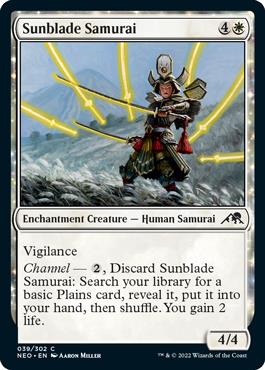
Every card with channel is basically a split card where you can choose either its basic functionality or its channel mode, which usually acts like another spell entirely. For example, Sunblade Samurai is either a decent vanilla creature or a Plains-only Environmental Sciences if you need help hitting lands on time. Flexibility is always appealing in Limited so a lot of cards with channel play better than they look.
While not a true build-around mechanic in any real sense, channel is featured on Simic’s () signature uncommon and has some nice synergies in the set, like Okiba Salvage, Season of Renewal, and Brilliant Restoration. These synergies take advantage of the fact that using the channel mode of a card places it in your graveyard for future recursion. Most creatures with channel are large or expensive so they’re convenient targets for reanimation!
Format Big Picture
Artifacts vs Enchantments
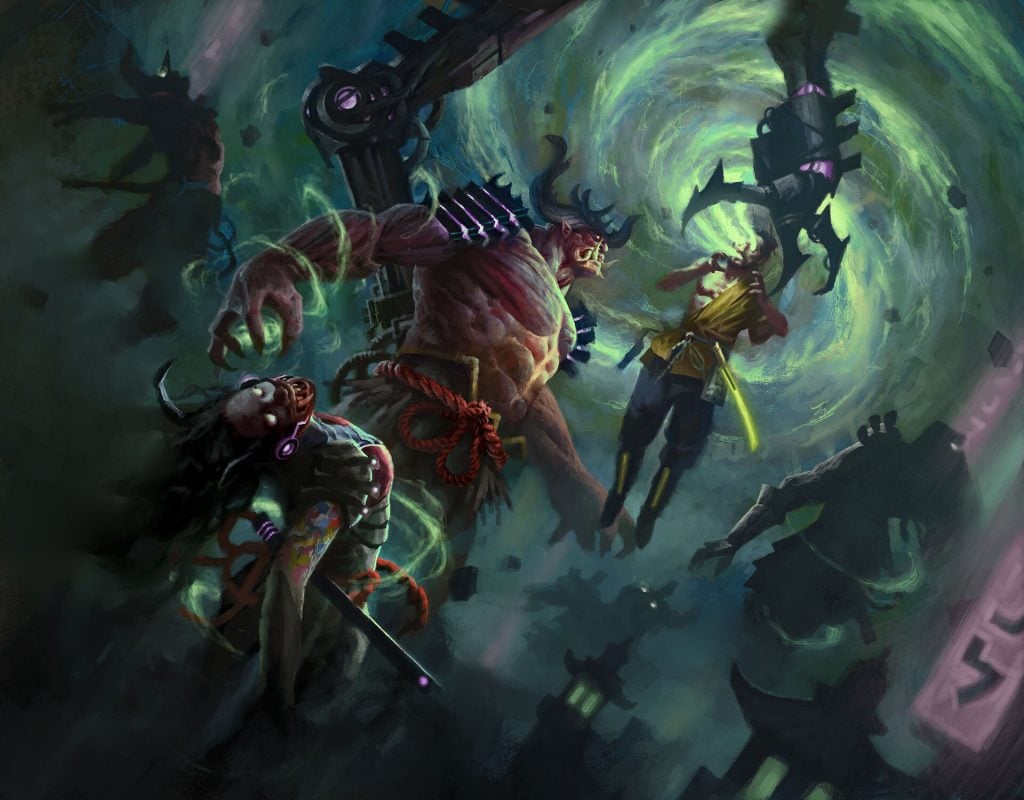
Soul Transfer | Illustration by Lorenzo Mastroianni
Although these guides are 99.99% about gameplay and not flavor, it is worth noting that artifacts showcase the new Kamigawa while enchantments represent the old Kamigawa. You can read more about this design here if you want, but I bring this up because of how it affects Neon Dynasty’s color balance.
Green has more enchantments than any other color, white has the second most, blue has the least, and red has the second least. Artifacts are the exact opposite, with blue and red having the most and white and green having the least. Black sits firmly in the middle of both categories.
This is relevant because there are three kinds of payoffs in the set that care about artifacts and enchantments. There are enchantment-density payoffs, like Generous Visitor and Sky-Blessed Samurai, and artifact payoffs, like Patchwork Automaton and Dragonspark Reactor. There are also payoffs like Kami of Terrible Secrets and Soul Transfer that care about you having both an artifact and an enchantment in play.
This focus on enchantments and artifacts also defines a lot of the basic strategies for 2-color combos in this format. Jukai Naturalist, Naomi, Pillar of Order, and Enthusiastic Mechanaut showcase how Selesnya (), Orzhov (), and Izzet () care about specific permanent types in this set.
Vehicles
Vehicles are featured a bit more prominently in Neon Dynasty than in any past set, including Kaladesh which introduced them. There are 13 vehicles in Neon Dynasty that appear across three colors and rarities. In case you haven’t played with vehicles in a while, think of them as conditional but oversized creatures that need other creatures to be useful.
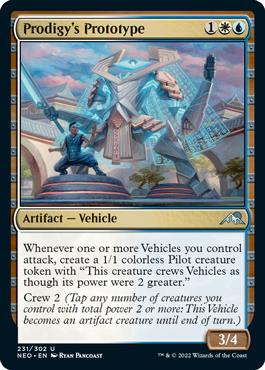
One notable feature of this set is Pilot tokens, 1/1 creatures that crew as though they were 3/1s. These are created by four cards across the set and access to them can allow you to play a few more vehicles than you otherwise might be able to. Vehicles are the primary draft theme of Azorius (), displayed by Prodigy's Prototype, but they can be played in all sorts of other decks.
There’s some tension in the set between vehicles, ninjutsu, saga creatures, and decks that care about enchantments. Ninjutsu has a self-involved gameplan that doesn’t play especially well with vehicles since you’re frequently tapping small creatures for other purposes. Saga creatures aren’t ideal pilots because they don’t start as creatures; Era of Enlightenment can’t crew Mukotai Soulripper until two turns after you play it. And decks that are concerned with reaching high enchantment counts should avoid playing all but the best of vehicles.
Shrines
Shrines are a returning card type from the original Champions of Kamigawa, with one difference: this time, all of the shrines are enchantment creatures. There are five shrines in the set, one for each color, each appearing at uncommon. All of the shrines are so-so creatures on their own with an ability that dramatically scales up in effectiveness with each additional shrine you play.
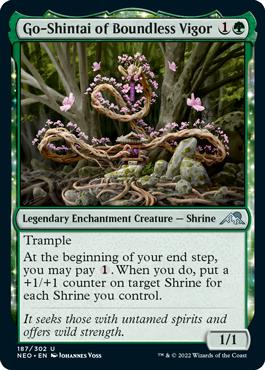
They’re mana-intensive and sluggish and work best in greedy control decks. Strategies like that can splash as many Shrines as possible and field enough mana to pay for all their activations. Go-Shintai of Boundless Vigor is the only Shrine I’ve been happy to play without any others since it’s cheap to play early and can grow at a passable climb on its own.
Speed
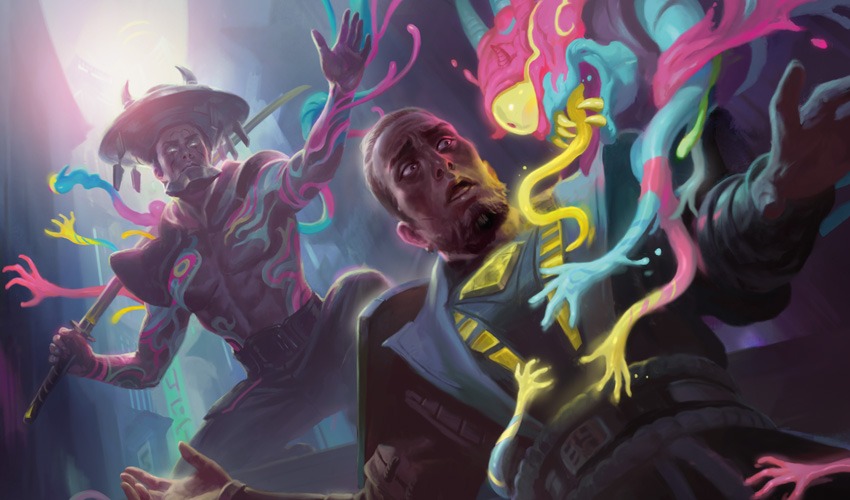
Assassin's Ink | Illustration by Heonhwa Choe
Neon Dynasty feels like one of the slowest sets in recent memory, with a lot of games going fairly long and coming down to card advantage and unanswered threats. There’s good common removal for large creatures and the sagas generally slow games down by not attacking until three turns after you play them.
My default mode in each color combo is to look for value and efficiency while being somewhat proactive to punish stumbles. I value hard removal like Assassin's Ink and Tamiyo's Compleation pretty highly and soft removal like Short Circuit less. Card advantage is essential since leaning too hard on 1-for-1 removal leaves you dead to cards like Imperial Oath that embarrass spot removal. But curving out is still important and there are a lot of good 2-drops that play well in terms of card economy while also letting you use your mana.
Prince or Pauper?
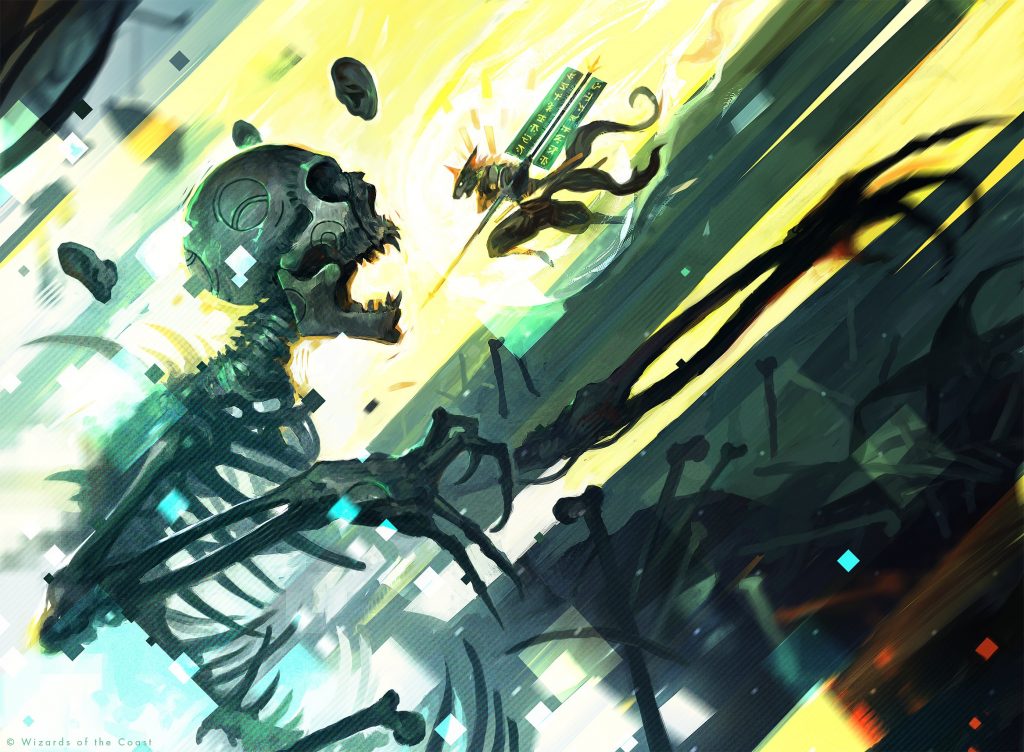
Repel the Vile | Illustration by Dominik Mayer
One concept developed by the Limited MTG community to evaluate formats is to describe it as a “prince format” or a “pauper format.” If you’re not familiar with the terminology, a prince format is dominated by higher rarity cards with a flat power level at common and uncommon and a lot of unbeatable bomb rares. Cards like Glorybringer, Dream Trawler, Ethereal Absolution, etc. By contrast, a pauper format is dominated by commons thanks to synergy, aggression, or common and efficient answers to large threats.
One great thing about Neon Dynasty compared to Crimson Vow is that the rares in this set are much less unbeatable than last time. The mythic dragon cycle, for example, is terrifying but also answerable by Intercessor's Arrest, Repel the Vile, and Tamiyo's Compleation. There are no unanswerable dumpster fire mythics like Avabruck Caretaker or “answerable” but 1000% dead mythics like Toxrill, the Corrosive.
That said, most of the rares in Neon Dynasty are still pretty good and there are definitely bombs to be opened. This means that you’ll be P1P1’ing a fair share of your rares, but the impact of rares on games varies from “I can’t beat that ever” to “I need to board in an extra Repel the Vile” to “that’s it?” A lot of these P1P1 rares aren’t inherently broken, just easy 2-for-1s or efficient cards that can run away with games, Examples would be Biting-Palm Ninja, Lizard Blades, and Fable of the Mirror-Breaker.
I’d conclude this Neon Dynasty is a format that straddles the line between prince and pauper. It’s possible to build very colorful decks that play lots of individually powerful cards where the format and your games will feel prince-like. But highly synergistic and effective builds like Selesnya Enchantments, Rakdos () Sacrifice, and Izzet Artifacts, are possible if you can find an open lane and the right balance of goods.
Gameplay Tips
Mythic Uncommons
One interesting thing about Neon Dynasty is that there are several uncommons that are better than a good chunk of solid P1P1 rares.
There are of course other strong uncommons, honorable mentions including Twinshot Sniper, Touch the Spirit Realm, and Assassin's Ink, but these are my picks for top 6. There isn’t a single common better than these cards and I’d take them over good rares like Cloudsteel Kirin, March of Wretched Sorrow, and Surgehacker Mech.
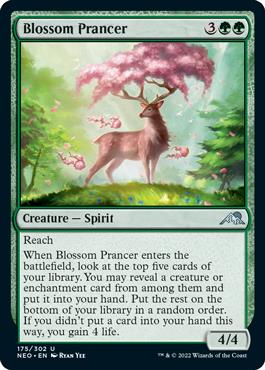
They don’t make 2-for-1s easier than Blossom Prancer. 4/4 for five with reach is already a fine deal, but you also get a free enchantment or creature thrown it plus four life if you brick or prefer it.
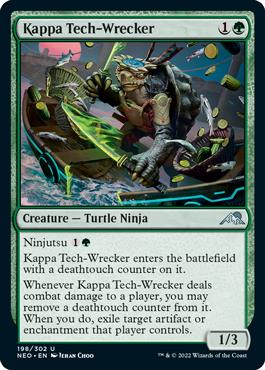
Oh boy, do I hate this turtle. I really do. Kappa Tech-Wrecker’s floor is high for two mana as a 1/3 deathtouch with a threatening upside, and it’s ceiling of looping it with ninjutsu to reuse the exile mode over and over is unbeatable. The massive amounts of artifacts and enchantments in just about every deck makes Naturalize effects play well, and this is the best one in the set.
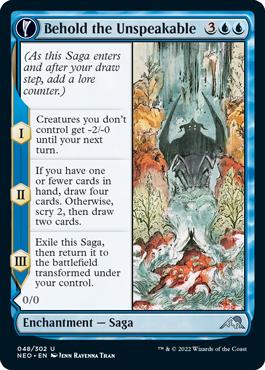

Behold the Unspeakable is a rare that just happens to show up in the uncommon slot. It slows down the game, draws two or four cards, and then gives you a free decently sized flier. Play carefully with Chapter 3 because playing lands and unneeded spells will shrink it, but by all means play and pick this card!
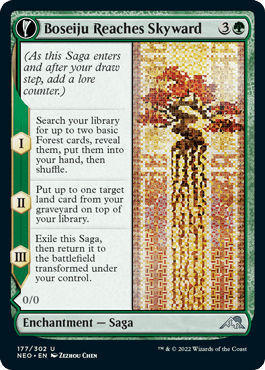
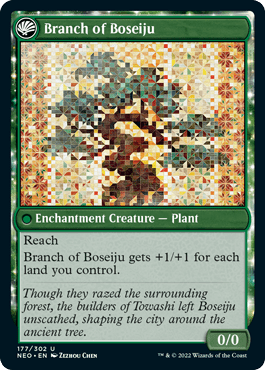
Boseiju Reaches Skyward is a 3-for-1! You get two Forests, a large creature with reach, and a useless 2nd chapter that no one will ever use. The creature comes out a bit slowly but blocking fliers and being the biggest thing on the board makes it more than worth the wait. Pair this with looting effects for best results, as the Forests are admittedly low impact if you are already flooding out.
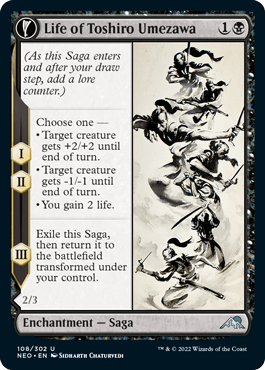
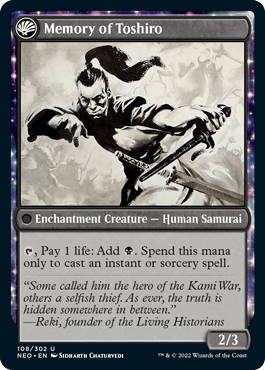
Life of Toshiro Umezawa is another potential 3-for-1, though realistically even a 2-for-1 off this feels great. All x/1 creatures in Neon Dynasty live in fear of this, but even if you can’t snipe x/1s you can gain life or push for damage instead. This is one of the best uncommons because of its high ceiling and floor. The worst this card can be is a delayed 2/3 that gains four life.
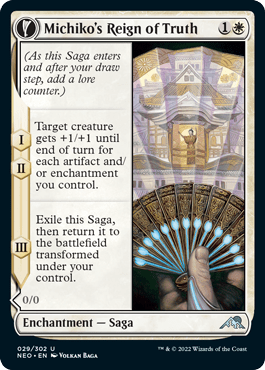
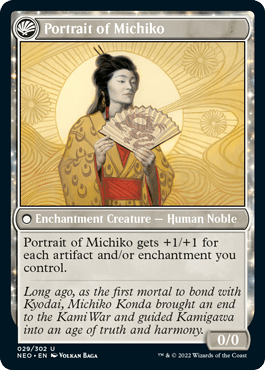
Michiko's Reign of Truth is the last mythic uncommon, and the highest variance one. Not all decks want this but those that do have absolutely terrifying output twice plus a creature to finish the job. Pair it with lifelinkers like Golden-Tail Disciple and Leech Gauntlet for best effect!
Mana Fixing
Neon Dynasty is primarily a 2-color set, though it has a surprising amount of fixing that makes splashing not only realistic, but usually correct. Splashing bomb rares and removal is a classic Limited strategy but this formatoffers two other reasons to splash: Shrines and 5-color payoffs.
But first, what are we splashing with?
Colorless Fixing
The two colorless mana fixers in the set are Ecologist's Terrarium and Network Terminal.
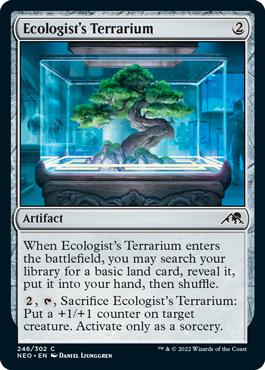
Terrarium is an overcosted but colorless Lay of the Land that also provides a disposable artifact. The artifact can also be sacrificed to itself for a clunky (but free) +1/+1 counter on a creature you control, which of course counts your creature as modified. It’s most effective in decks with artifact or modified synergies that need to slightly splash certain cards and requires at least one basic of your splash color(s).
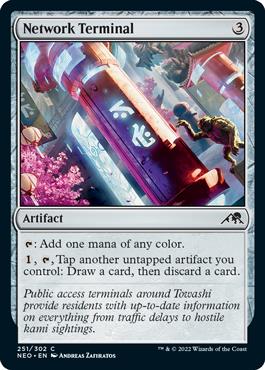
Network Terminal is a Manalith with a looting upside. Looting is appealing because one of the main drawbacks of these kinds of cards is that you’re increasing the number of mana sources in your deck, which can lead to flooding. A deck with 17 lands and three Manaliths effectively has 20 lands since Manalith does nothing but provide mana. Terminal inherently mitigates this but needs you to have other artifacts for you to use its ability. With that in mind, it performs best in controlling artifact decks looking to splash powerful cards.

The other form of fixing available for any decks are the nonbasic lands in the set. There are 10 duals at common plus Uncharted Haven, which can be any color you want it to.
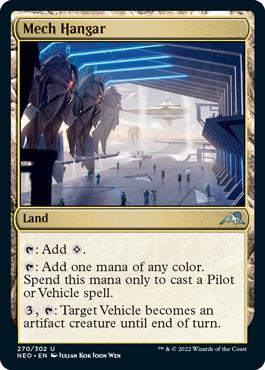
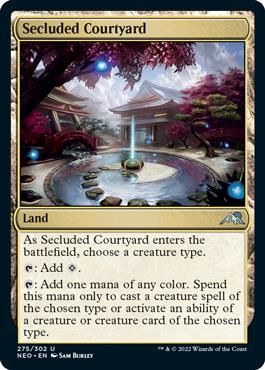
At uncommon there’s Mech Hangar and Secluded Courtyard as additional options for fixing. Hangar can splash certain vehicles like Prodigy's Prototype but plays better as a “spell land” for vehicle-heavy decks that can rely on it to crew in the late game. Courtyard is narrow but can be good if you’re splashing certain powerful creatures. But be aware that Shrine is not a creature type so it can’t be named with Courtyard.
Green Fixing
Green is the best color for splashing in Neon Dynasty, as you’d expect. But its options aren’t especially vast nor dramatically superior to existing colorless options. Grafted Growth and Greater Tanuki are the only cards in green that can help you generate different colored mana.
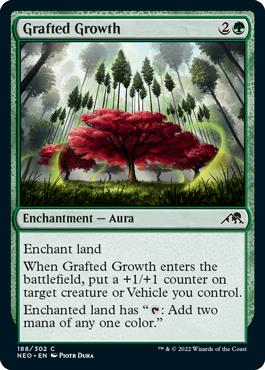
Grafted Growth has been stronger for me than New Horizons-style cards usually are since the +1/+1 counter is relevant for modified and its rate for splashing is acceptable. It’s also the only source of fixing in the format that can generate two pips of any color, which means that multiple Growths can open up bold splash options like playing Ao, the Dawn Sky with no Plains!

Greater Tanuki is one part Natural Connection one part Colossal Dreadmaw. This is an appealing package for big mana decks so I’ve definitely enjoyed Tanuki as a solid all-around playable. It’s similar to Ecologist's Terrarium in that both cards ask you to play at least one basic for whatever color(s) you splash.
Other Fixing
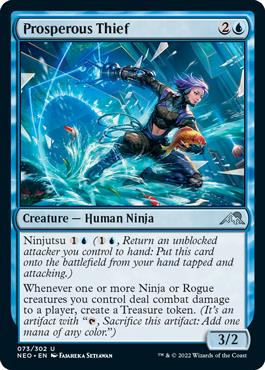

There isn’t too much other fixing in the set, but there are a few cards worth mentioning. Treasure appears on a few cards, notably Prosperous Thief and Undercity Scrounger which can be counted as soft sources of another color.

Decks looking to splash a few white cards can take advantage of Sunblade Samurai being a colorless source of white mana that doubles as a fine creature later. This is especially relevant because of Imperial Oath and white’s strong removal options at common.
What to Splash?
- Bombs, obviously. You can’t splash double pip cards without multiple Grafted Growths, so this is usually single-color bombs like Kaito Shizuki, Tamiyo, Compleated Sage, and The Reality Chip.
- Removal if you can’t get good removal in your base colors. White is the most common color splashed this way for Intercessor's Arrest or Repel the Vile.
- Imperial Oath deserves a mention since it’s easy to splash and a surprisingly powerful late-game card. Not quite a “bomb,” I guess, but it can sometimes feel like one.
- Payoff cards that line up well with what your deck is doing. Splashing Michiko's Reign of Truth in a dedicated Izzet Artifacts deck is a fantastic idea.
Sideboarding
As a set with many main deck-able artifacts and enchantments, Fade into Antiquity and similar cards are very playable game 1. Cards that I haven’t liked to start are Lucky Offering and Explosive Entry, which are weak or dead against decks focused on enchantments. But these are some of the best sideboard cards in the format since they’re supremely efficient against artifact-focused strategies.
Other cards that are frequently sideboarded in (and out) are Repel the Vile, Intercessor's Arrest, Tamiyo's Compleation, Short Circuit, Lethal Exploit, Voltage Surge, and Malicious Malfunction. What all of these cards have in common is that they’re interactive spells that are good against certain types of cards but so-so or actively weak against others.
Repel and the Arrest variants excel against larger creatures, dragons, and other bombs but play poorly against low curve decks like Rakdos and Izzet Artifacts. On the other hand, Voltage and Exploit are terrible cards for being proactive against a durdly 5-color deck with Imperial Oath and make for easy cuts.
Best Commons
White
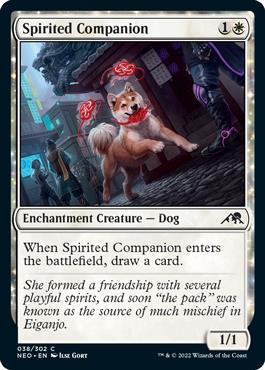
The floor onSpirited Companion is a white Elvish Visionary, but it’s usually better than that thanks to synergies with enchantments, Season of Renewal, and ninjutsu value. No white deck is ever cutting this and many actively want as many copies as they can get. Plus it’s so cute!

Free consistency is always good, so Sunblade Samurai has excelled as a way for white decks to play a bit more mana without the downsides of mana flood.

There are some cards that play against Arrest effects in this set, but Intercessor's Arrest is still a versatile answer to big creatures, dragons, vehicles, and anything else you need detained.
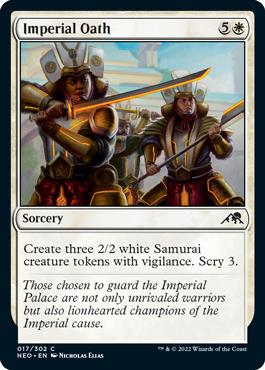
Six mana is a lot but you’re definitely getting your mana’s worth with scry 3 and three 2/2s. Especially good in multiples since the first Imperial Oath can scry you into subsequent copies and bury your opponents in 2/2s.
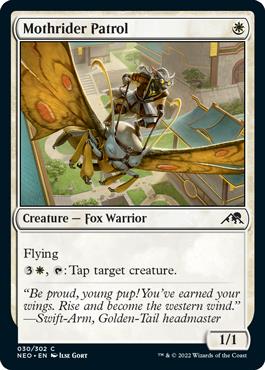
Mothrider Patrol is a cheap and efficient flier that’s strong with samurai pseudo-exalted abilities and ninjutsu. The tap ability also keeps it from falling off entirely as the game goes on.
Blue

The base rate of a 2/2 for that bounces is pretty good, so being able to ninjutsu Moonsnare Specialist for just makes a great common even better. This is a strong tempo card that also picks up value against Pacifism-style effects.
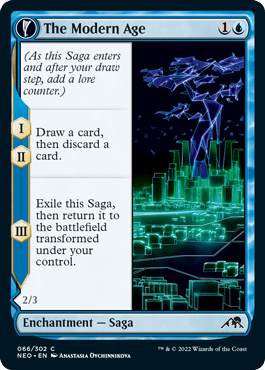

The Modern Age is a top-notch common saga that smooths out your early draws and morphs into a respectable flying body later. This is excellent in blue midrange and control decks that need to hit their land drops and aren’t particularly concerned with immediately setting up ninjutsu.

Moon-Circuit Hacker is another creature with a decent base rate and a stronger ninjutsu mode. It smooths out your draws and gets excellent value in dedicated ninjutsu decks.
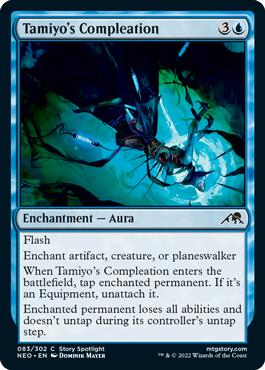
Tamiyo's Compleation is surprisingly strong and mostly unconditional removal that does a great job at answering most bombs. This is unusual for a mono-blue card and it’s also quite splash-able for decks that need answers to bombs. It’s at its weakest against cheap creatures and bounce effects.
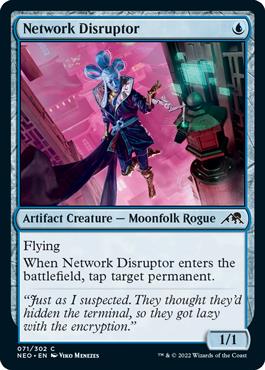
I don’t have much interest in Network Disruptor in decks with no ninjutsu but it’s the single best ninjutsu enabler in the entire set. This card is especially valuable because the tap ability plays well with returning it to your hand.
Black
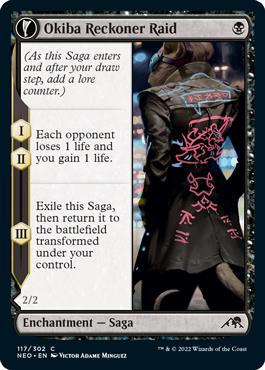

Okiba Reckoner Raid is the best common saga and black’s best common. It’s good in every Bx deck and great in multiples. Think of it like a 1-mana Vampire Spawn that also upgrades your vehicles and plays well with ninjutsu since it’s evasive and super cheap to replay.
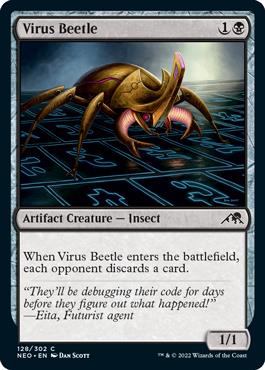
Virus Beetle is an excellent value creature that plays well with ninjutsu and artifact synergies. It’s also good sacrifice fodder for cards like Reckoner's Bargain and Dockside Chef.
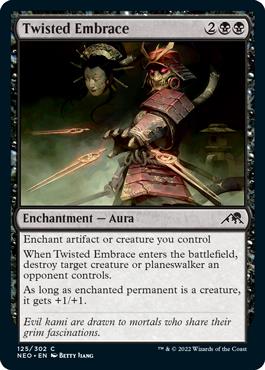
Twisted Embrace is a clunky but powerful removal spell that provides modified and kills any creature. Try to play this when your opponent is tapped out if you can since you can get blown out in response and won’t get the Impale effect.

Inkrise Infiltrator is a great ninjutsu enabler with a powerful shade-style ability that makes it hard to block and threatens late game win condition.

Lethal Exploit is cheap removal that scales well with modified, but black only has one other incentive to care about modified in Unforgiving One. This card is best in decks that can reliably get it to -3/-3 or more but is always playable at -2/-2.
Red

Kami's Flare is red’s best common as a no-frills removal spell. Two mana for three damage is a classic Limited rate and the extra two face damage isn’t too hard to set up either.
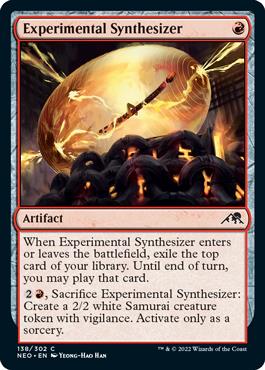
Experimental Synthesizer is cheap and scalable card advantage that’s excellent in Rakdos or any base-red deck. This card is good on its own and even better if you have convenient ways to sacrifice it. Try to build your deck around this if you have multiples, avoiding combat tricks and situational cards to build around impulsive draw.

Shock with upside is another classic Limited all-star. Voltage Surge excels in artifact-based decks but is generally playable anywhere, like Lethal Exploit but with an easier deckbuilding ask.
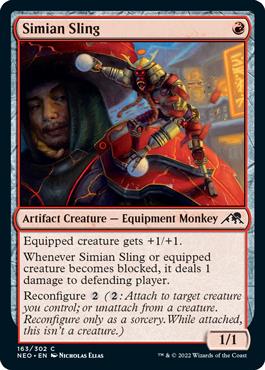
Simian Sling is an aggressive card, but red is generally an aggressive color so most red decks are good Sling decks. It pokes for a bit of damage early and then does a nice Short Sword impression, letting you trade up other creatures while dealing incidental damage from its “becomes blocked” trigger.
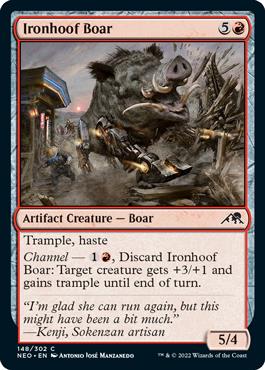
for +3/+1 trample is a normal Limited combat trick, so having a split card that’s that plus a fat angry pig for no cost seems good. Ironhoof Boar plays especially well with samurai since trample punishes chump blocking.
Green

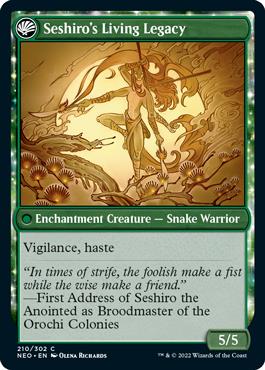
7/7 worth of stats over three turns plus vigilance and haste when it finally arrives makes Tales of Master Seshiro a very strong curve topper for any green deck. Its sole request is that you play a good number of creatures for chapters 1 and 2, but that’s a good idea regardless.

Master's Rebuke is an excellent Rabid Bite variant since it has the same cost as its basic version but is instant. Pair Rebuke with large creatures, a high creature count, or deathtouch-ers for best results.
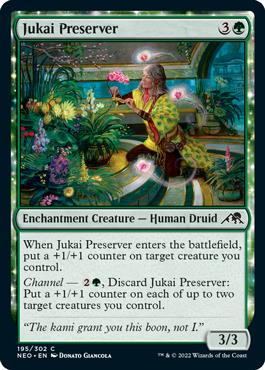
Jukai Preserver is a 4/4 for four, an easy source of modified, and a combat trick on top of that if you want it. It’s flexible and efficient and excels in aggressive and enchantment-focused green decks but is always playable thanks to its good sizing.
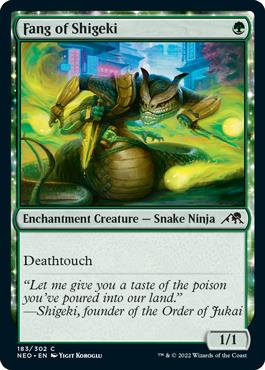
Fang of Shigeki is a cheap defensive creature that excels against large ground beaters like vehicles, Greater Tanuki, and the like. It’s weakest against cards like Seismic Wave and Life of Toshiro Umezawa that punish x/1s.

Fade into Antiquity is better in Neon Dynasty than it’s ever been in the past since there are so many good targets for it in just about every deck. The first copy is great and extra copies can definitely be played or boarded in if you have them.
Colorless
Most colorless commons are just medium or worse filler for artifact-interested decks, but a few of them are decent enough to be worth mentioning.

Ninja's Kunai is a surprisingly efficient removal spell that also works as a medium enabler for modified cards. You can cheaply equip Kunai and wait until you’ve played your card(s) that care about modified to use it. Three damage for three mana in payments of 1/1/1 isn’t a bad rate at all, but try to play a higher creature count alongside this since you need to have creatures to use it.

Searchlight Companion is the best colorless ninjutsu enabler since it’s evasive and gives you a small amount of value for replaying it.

Shrine Steward is a good value creature for greedy control decks since it can help you assemble multiple Shrines and grab Tamiyo's Compleation or Intercessor's Arrest if needed. That said, I wouldn’t play it in the average deck with one or two targets since the body is terrible for its cost.
Archetypes
As with most MTG sets, Neon Dynasty features 10 dual color archetypes, each with their own signpost card roughly indicating what the deck does or should be doing. The archetypes are a great starting point for your decks but keep in mind that this setis much less rigid than recent sets like Crimson Vow. These are good guidelines for available decks but hardly the only viable strategies.
Azorius Vehicles
Azorius has a prominent vehicles theme in this set and is the only archetype that can get away with playing a lot of the clunkier vehicles like Mobilizer Mech and Futurist Sentinel. A focused Azorius Vehicles deck is a stompy strategy that looks to play undercosted vehicles and then cheat on crew restrictions with Pilot tokens.
Best Payoffs

Prodigy's Prototype is one of the most powerful signpost uncommons, particularly because it ties together a theme that’s otherwise somewhat lacking. Vehicles with prototype out quickly become self-sustaining which removes all the clunkiness from them and makes them huge undercosted beaters. The 1/1 tokens themselves can also be useful for chump blocking or going wide in contested board states.
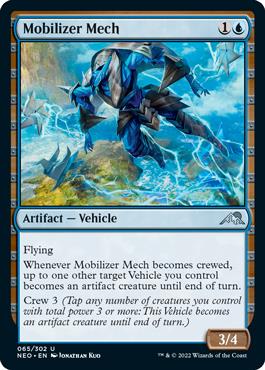
Mobilizer Mech also deserves a mention as another card that plays well with high vehicle counts. Crew 3 is a bit tricky to manage but if you can play some 3/xs or Pilot tokens then this alleviates the pressure of having to crew your other vehicles.
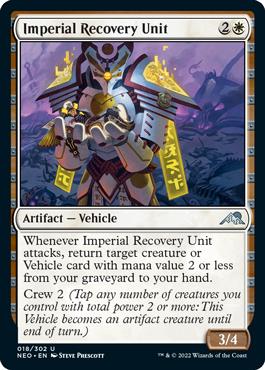
Imperial Recovery Unit is another high-quality vehicle, though its effectiveness depends on having good mana creatures for it to return.
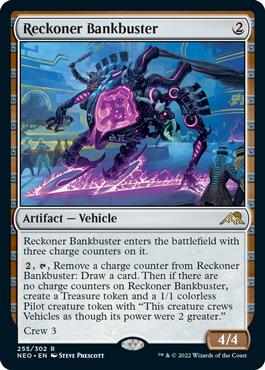
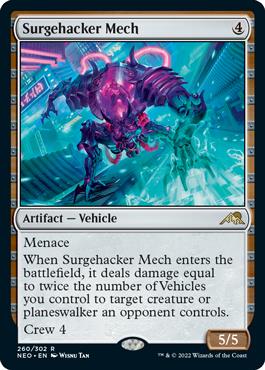
The best vehicles are of course rares, specifically Reckoner Bankbuster and Surgehacker Mech. Bankbuster is just awesome on its own as a Mazemind Tome on legs in any deck while Mech is decent on its own but filthy in decks that play other vehicles alongside it.
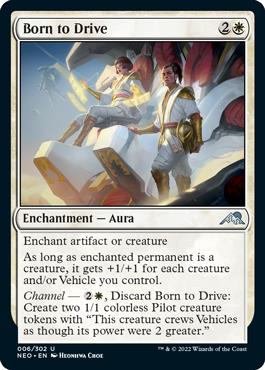
Pilot tokens aren’t easy to come by so a dedicated vehicles deck is eager to get its hands on any cards that can make them. Born to Drive is mediocre outside of Azorius but is exceptional in a deck built around this theme. You’ll mostly be using the Pilots mode, but the aura mode also makes this a much better top deck than it would be otherwise.

Mech Hangar is also highly desirable and well worth playing over a basic land.
Useful Cards
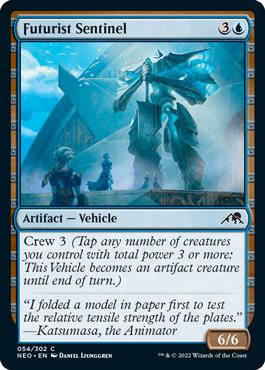
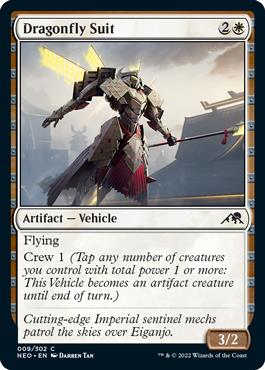
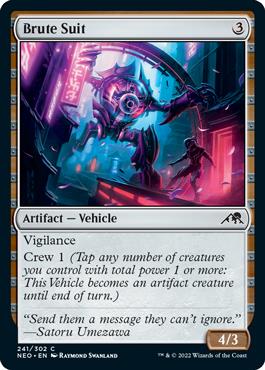
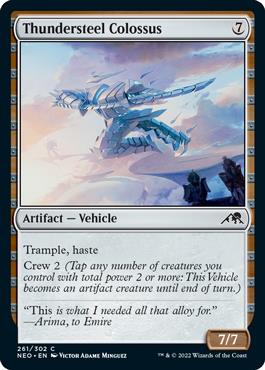
All of the common vehicles are playable but none of them excel. Futurist Sentinel is great in decks with lots of Pilot support but too clunky without it. Dragonfly Suit and Brute Suit are less risky but also less rewarding. Thundersteel Colossus is an expensive but powerful curve topper or sideboard card for crushing board stalls.
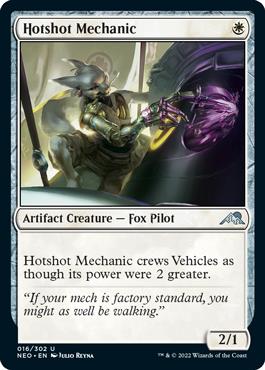
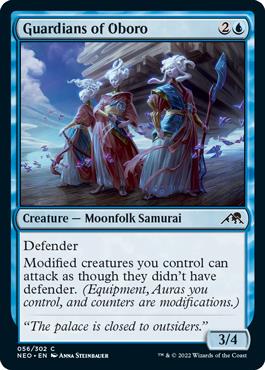
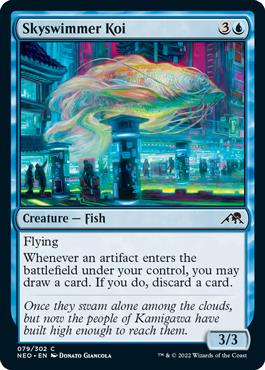

Vehicles are nothing without creatures to crew them, so it’s worth looking at which non-rare creatures do a good job of this. There aren’t actually many options for creatures to do crew 3 on their own if that’s what you’re looking to do. Hotshot Mechanic, Guardians of Oboro, Skyswimmer Koi, and Sunblade Samurai fit this description, but two of them cost 4+ mana.


Crew 2 is much easier and there are many good 2-power creatures for this: Kitsune Ace and Moonsnare Specialist are both good ones. Kitsune is also notable for giving your vehicles first strike which plays best with Brute Suit and Futurist Sentinel.


Don’t let the vehicle theme keep you from playing plain good Azorius cards. Imperial Oath, Intercessor's Arrest, and other great Azorius commons do well in any Azorius deck. What makes an Azorius deck a “vehicle deck” or not is its density of played vehicles, payoffs, and enablers. Some decks lean minimally into this theme and only play a Prototype or one other vehicle while others play upwards of six or seven thanks to having multiple Prodigy's Prototypes or Born to Drives.
Trophy Example
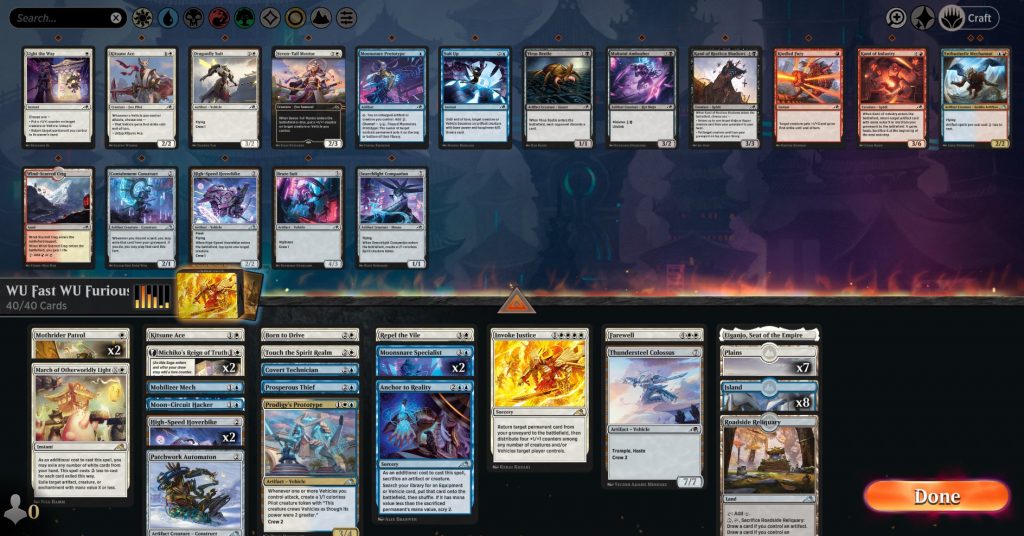
Dimir Ninjas
This is one of the stronger archetypes and also the most drafted thanks to its power and fun factor. Dimir Ninjas is primarily a tempo strategy that wants to assemble cheap creatures plus ninjas to gain various advantages from the ninjutsu mechanic.
Best Payoffs
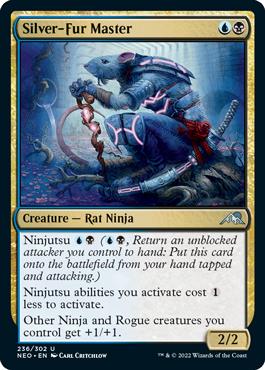
Silver-Fur Master is an efficient tribal lord that also reduces ninjutsu costs and has ninjutsu itself. It’s a high output card for just two mana and a great sign that Dimir is open if you see one late. There are some other good uncommon ninjas like Dokuchi Silencer and Nezumi Prowler, but Dimir doesn’t depend much on higher rarity cards to be effective.

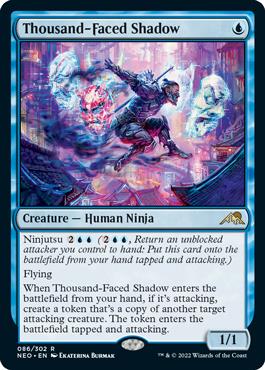

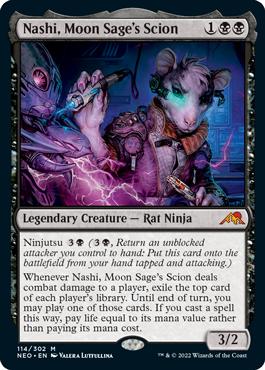
But if you’re lucky enough to open some rares, Satoru Umezawa, Thousand-Faced Shadow, Biting-Palm Ninja, and Nashi, Moon Sage's Scion are all excellent. Satoru is particularly interesting. It’s only great in a deck themed around the ninjutsu mechanic since you’d rather Impulse off cheaper ninjutsu abilities than pay every time.
Useful Cards




The bread and butter of Dimir Ninjas is enabler plus ninja. The best enablers are Network Disruptor, Inkrise Infiltrator, and Okiba Reckoner Raid.



Virus Beetle and Modern Age are also solid but definitely inferior to the rest. Good ninjas decks feature as many copies of these cards as possible and then fill the rest of the deck out with six to 9 ninjutsu cards and some interaction and bombs.


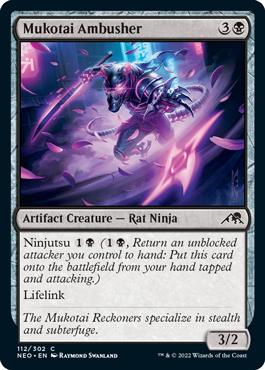

There are no terrible ninjutsu cards in the set, though some are definitely better than others. The best ones at common are Moonsnare Specialist and Moon-Circuit Hacker but you’d also be happy to play Mukotai Ambusher and Dokuchi Shadow-Walker. I recommend prioritizing the best enablers over all ninjas except Moonsnare, Silver-Fur Master, and the rare ninjas, but you can deprioritize them once you have 5+ cheap fliers.

Outside of these cards I like to play some removal and a copy or two of Kami of Restless Shadows. Though quite expensive, Kami is best in Dimir thanks to the high density of ninjas and rogues in the deck. It can be sidelined in the best 16-land builds but makes for a fine curve topper for more average 17-land versions.
Trophy Example

Rakdos Sacrifice
Rakdos Sacrifice can be built as a value or an aggressive deck, though the builds I’ve had the most success with lean more towards value. Look for cheap and disposable artifacts and ways to sacrifice them or benefit from doing so.
Best Payoffs
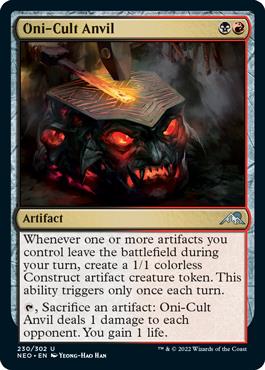
Oni-Cult Anvil showcases Rakdos’ unique goals in this format. It can sacrifice a 1/1 Construct each turn to make a replacement and drain one life on its own. This is admittedly underwhelming but you can pick Constructs up from other card effects and multiple Anvils stack exceedingly well.
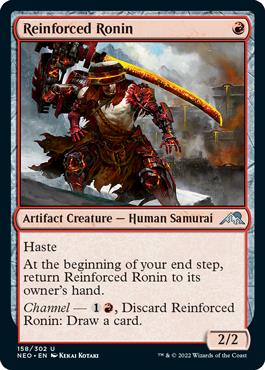
Reinforced Ronin is another card that excels in Rakdos. It’s an in-built combo with Anvil since Anvil sees it leave the battlefield every turn, letting you net a 1/1 Construct on each end step without having to sacrifice anything.
Ronin is also a combo with Kami of Industry and Containment Construct. You can cycle it and get it back freely with Kami while Containment makes Ronin into a repeatable card draw engine (cycle it, replay it, do it again next turn).
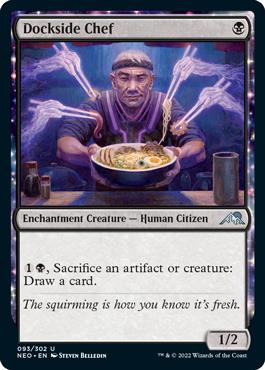
Another engine card that excels in Rakdos is Dockside Chef. It’s a hyper efficient source of card advantage that plays well in a deck that wants to sacrifice artifacts and small creatures for profit.
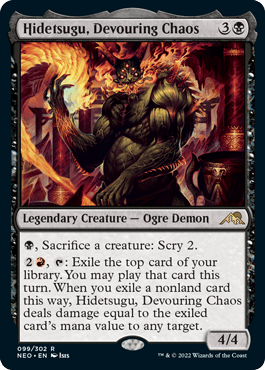

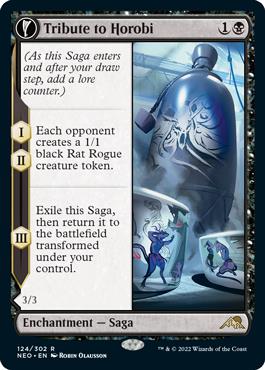
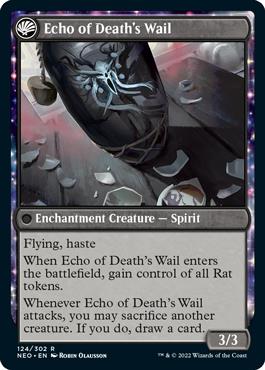


Some great rares in Rakdos are Hidetsugu, Devouring Chaos, Mukotai Soulripper, Tribute to Horobi, and Fable of the Mirror-Breaker. The artifact and sac theme mostly functions off a density of uncommon payoffs and common enablers so all these rares are generally great, and not just in Rakdos.
Useful Cards

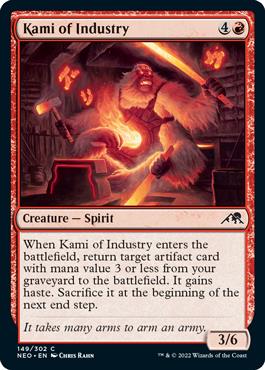
Rakdos is a pretty flexible deck to build at common. The best commons are efficient removal, Virus Beetle, and Kami of Industry. Kami is expensive but is a fine blocker that makes for a powerful late game value play with Reinforced Ronin, Experimental Synthesizer, and the like.
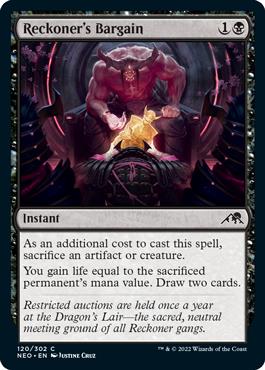

Reckoner's Bargain and Searchlight Companion are good support cards. You want artifacts, fodder, 1/1 tokens, and ways to sacrifice things for value.
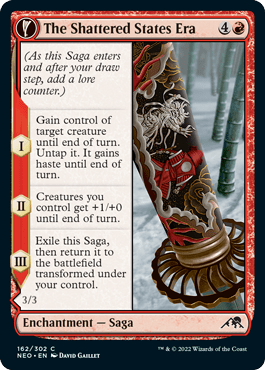

The Shattered States Era can also be considered if you have a lot of sacrifice effects for the classic Treason and sac combo, but keep in mind that it costs five mana which makes it somewhat impractical.

Another card I’ve liked in some Rakdos builds is Undercity Scrounger. If you’re playing artifact sac payoffs, the Treasure tokens it creates are among the freest possible game objects to sacrifice.
Trophy Example
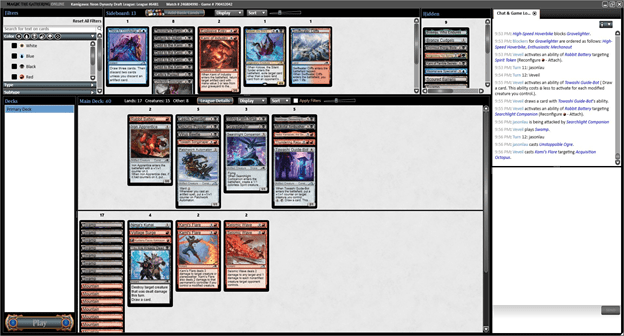
Gruul Modified
Gruul Modified is an aggressive strategy that wants to modify its creatures to enable various payoff cards that reward you for doing so.
Best Payoffs

Invigorating Hot Spring is an exceptional Fires of Yavimaya variant. It’s threatening in a vacuum but especially good with other cards that care about modified. This is a source of up to four modifications on its own, which is completely absurd if you think about it.


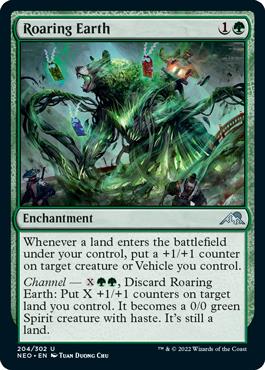

Some excellent uncommon payoffs for this deck are Walking Skyscraper, Flame Discharge, Roaring Earth, and Towashi Guide-Bot.
Skyscraper is the best non-rare payoff thanks to its absurd sizing and built-in protection. Your goal should be six mana, but if you can get it even lower you are doing it.
Discharge is fine on its own but premium removal in a deck that can easily meet its bonus condition.
Earth is an extremely convenient way to stack up modifications with free +1/+1 counters on land drops.
The Guide Bot’s card draw ability scales dramatically in efficiency as you modify more creatures and even comes with a counter itself.

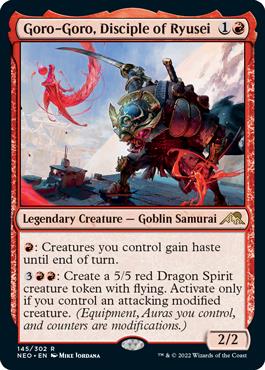
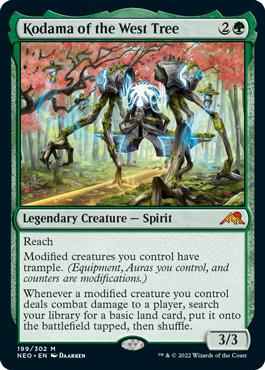

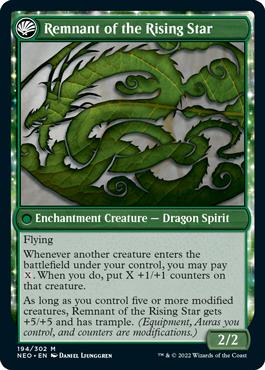
The best rare payoffs for modification are Thundering Raiju, Goro-Goro, Disciple of Ryusei, Kodama of the West Tree, and Jugan Defends the Temple. All of these are frankly just bomb rares even in non-dedicated decks, but they have a sky-high ceiling in a Gruul deck fully built around the modified mechanic.
Useful Cards



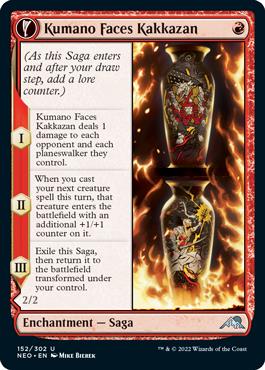
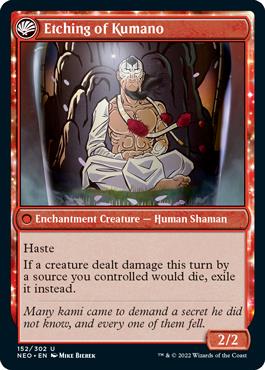


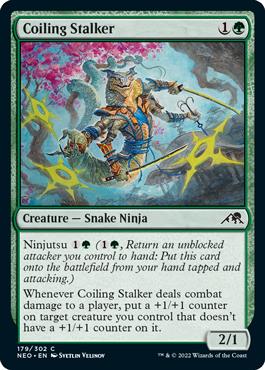
Jukai Preserver, Harmonious Emergence, Crackling Emergence, Kumano Faces Kakkazan, Tales of Master Seshiro, and Coiling Stalker are some of the better commons and uncommons for achieving easy modification without playing lackluster cards.

Kami's Flare is solid with no upside but premium in Gruul since you get that +2 damage most of the time.
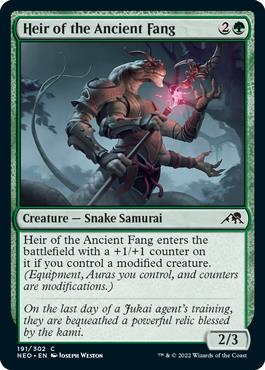

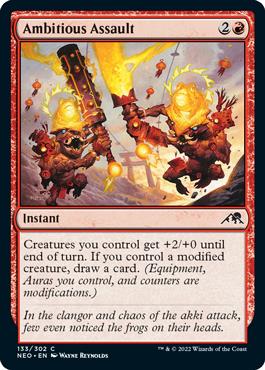
There aren’t many good common payoffs that care about modified. Heir of the Ancient Fang, Akki Ember-Keeper, and Ambitious Assault felt average at best to me. But they’re still fine filler cards for the deck since having a good mana and creature curve is important.
Trophy Example
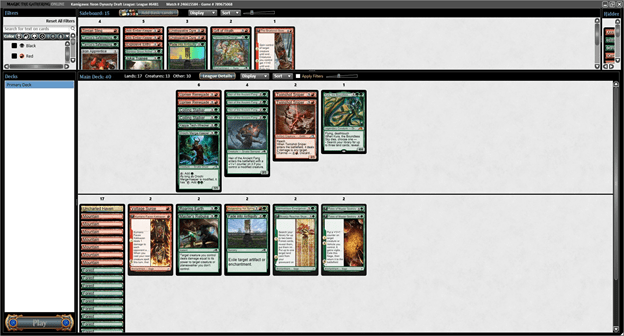
Selesnya Enchantments
Selesnya is a midrange strategy that’s all about focusing on enchantments for a variety of benefits.
Best Payoffs
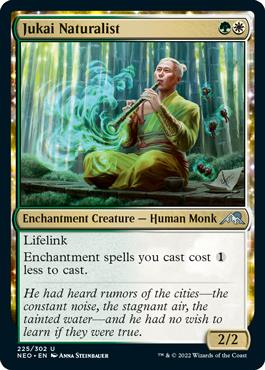
Jukai Naturalist is a good creature on its own, but the cost reduction ability is obviously the real draw in a strategy focused on enchantments.
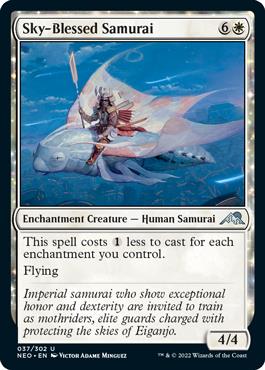



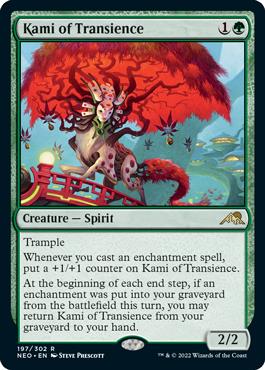
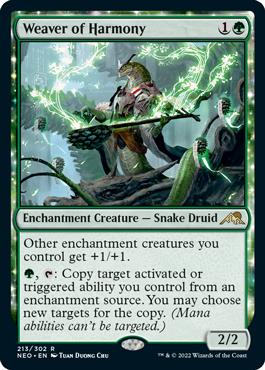
Some of the best cards in the format that reward you going deep on enchantments are Sky-Blessed Samurai, Michiko's Reign of Truth, Generous Visitor, Kami of Transience, and Weaver of Harmony. Weaver may be the ultimate payoff since its cheap activated ability lets you double up many powerful triggers from your enchantments.
Useful Cards




Filling up a Selesnya Enchantments deck is easy since there are a lot of playable enchantments in the set. Some of the best ones are Spirited Companion, Intercessor's Arrest, Sunblade Samurai, and Tales of Master Seshiro.
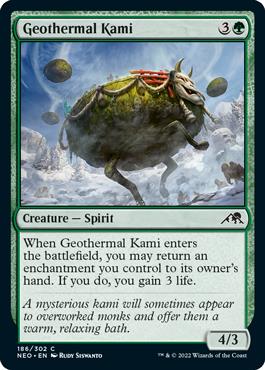
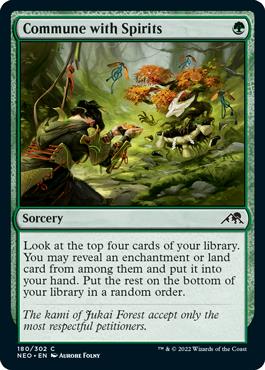
Two non-enchantment cards that work really well in Selesnya are Geothermal Kami and Commune with Spirits.
Geothermal has a fine vanilla body on its own, but its true appeal is its synergy with cards like Spirited Companion. This is a simple but effective value play that I’m never turning down in any Selesnya deck.
Commune improves the basic consistency of your deck for a very low cost, letting you play more enchantments and sometimes also have a land. You want to build your mana base to cast Commune on turn 1 for best results.

If you’re going to play non-enchantments in Selesnya you should probably have a good reason for it. Bomb artifacts like Reckoner Bankbuster still make the cut, but avoid medium ones in favor of slightly worse enchantments if you can. I’d rather play Bearer of Memory than Dragonfly Suit in just about every Selesnya deck regardless of what I think of the two cards in a vacuum.
Trophy Example
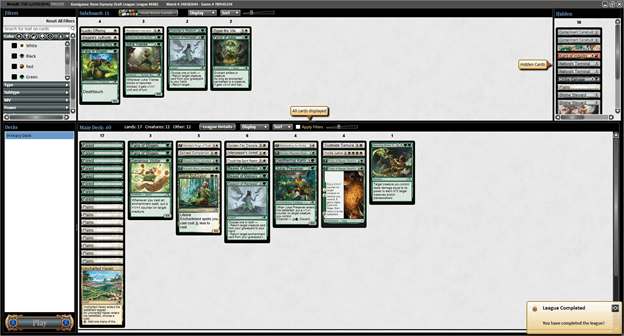
Orzhov Balance
While Izzet and Selesnya seek to amass either enchantments or artifacts, Orzhov is satisfied to straddle the line between the two. The deck is a midrange strategy with a variety of payoffs for controlling both an artifact and an enchantment. This theme unifies the vast majority of Orzhov decks but is also flexible enough that you can build them with all sorts of cards.
Best Payoffs
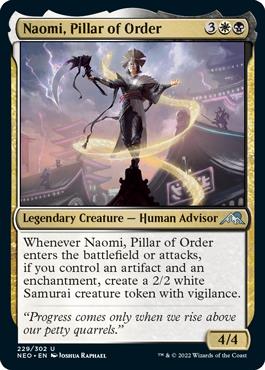
Naomi, Pillar of Order is a typical signpost in that it shows off what a color pair wants to do while also being one of the better reasons in the set to do it. for a 4/4 plus a 2/2 is a great rate so getting attack triggers on it is just gravy. Conversely, 4/4 for is not so great so you definitely want to build your deck around this condition.

There actually aren’t a ton of super juiced payoffs for this theme besides Naomi. Soul Transfer is juiced but it’s the only rare with this theme.

Banishing Slash is probably the next thing after Naomi for a theme reward.
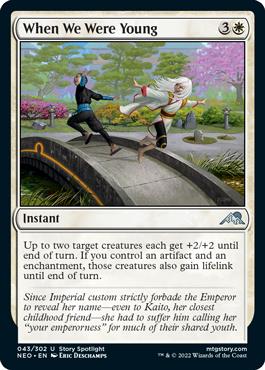
When We Were Young is a clunky combat trick but a strong payoff if you can build a creature-dense deck with lots of artifacts and enchantments.

Assassin's Ink is phenomenal but also doesn't need the double discount to be good.
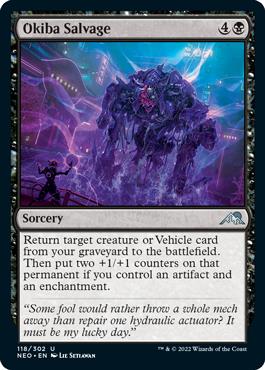
Okiba Salvage has the right text on it to look like a great Orzhov card, but I wouldn’t recommend it outside decks with multiple copies of Sunblade Samurai.
Useful Cards
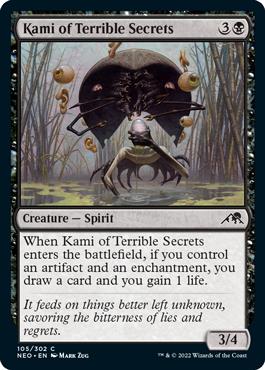
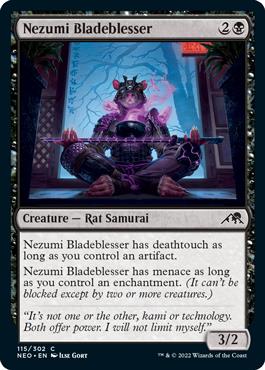
Kami of Terrible Secrets is your bread-and-butter creature. My ideal Orzhov deck has four or five copies of this card, a mix of enchantments and artifacts including creatures and removal, and some higher rarity payoffs. Nezumi Bladeblesser has the same reward line but is much less rewarding and actually gets cut from some Orzhov decks I build in favor of creatures that are also artifacts or enchantments.



As a midrange strategy you want a balance of artifacts, enchantments, removal, card advantage, and mana curve. Aim for 7+ of both artifacts and enchantments, leaning on cards like Twisted Embrace and Intercessor's Arrest for enchantments that double as removal. Spirited Companion is also wonderful, as always.


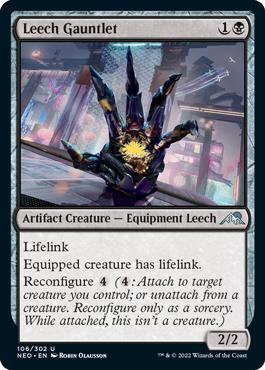
Good artifacts are harder to come by in Orzhov than good enchantments, so the few great ones like Virus Beetle, Circuit Mender, and Leech Gauntlet should be prioritized.

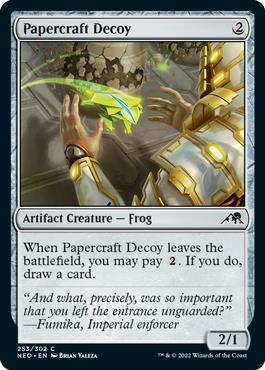

If you have to make do with lesser filler I’ve liked Ninja's Kunai, Papercraft Decoy, and Searchlight Companion well enough to help hit 7+ artifacts.
Trophy Example

Izzet Artifacts
Izzet’s closest counterpart is Selesnya Enchantments since both decks focus heavily on one card type for a variety of different payoffs. As is typical for the Izzet color pair in Limited, it can be built either aggressively or as more of a control strategy.
Best Payoffs
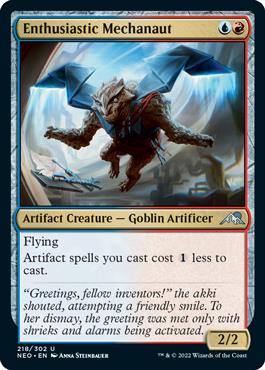
Enthusiastic Mechanaut is a decently-sized flier that dramatically speeds up the rate at which you can field new artifacts. It’s one of the better signposts in the set and particularly good with cheap colorless cards thanks to the nature of its discount.
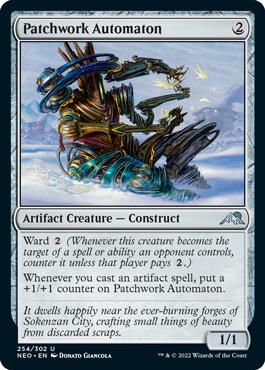

Patchwork Automaton and Dragonspark Reactor are strong payoffs for focusing on this theme with both cards excelling if you can repeatedly cast artifacts.
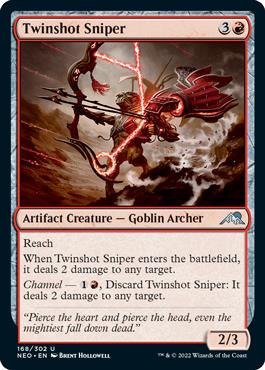



There aren’t too many linear cards that pay you off for artifacts besides those three, so take them highly and fill the rest of your deck up with good artifacts. Some awesome uncommons are Twinshot Sniper, Circuit Mender, Containment Construct, and Acquisition Octopus. Containment was already mentioned for its synergy with Reinforced Ronin, but it’s also great with The Modern Age, Thirst for Knowledge, Skyswimmer Koi, and Mnemonic Sphere, making it particularly good in blue decks.


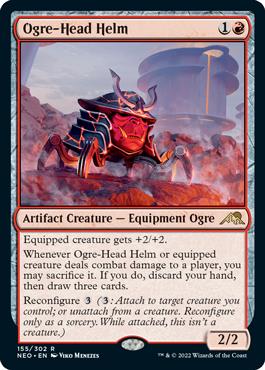
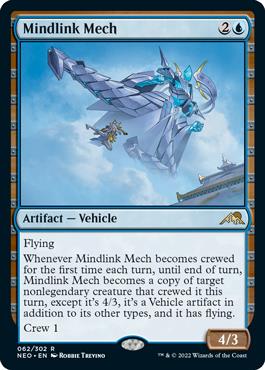
Some great rares in Izzet are The Reality Chip, Lizard Blades, Ogre-Head Helm, and Mindlink Mech. These are all hyper efficient artifacts that scale as the game goes on.
Useful Cards

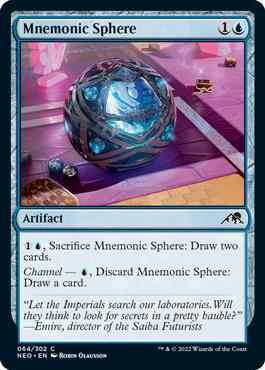

Artifacts are of course essential, and some of the best common ones in Izzet are Experimental Synthesizer, Mnemonic Sphere, and Moonsnare Prototype. This is because Izzet wants to get on board quickly but also have access to card advantage to keep its engine flowing. Prototype is hyper efficient ramp in Izzet and also doubles as Griptide if ramp isn’t needed while Sphere and Synthesizer are both solid card draw.
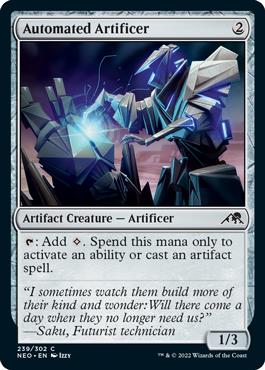
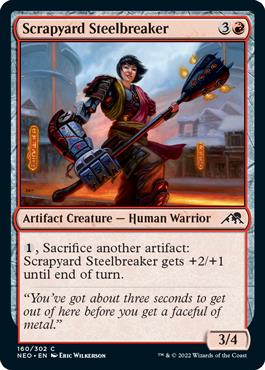
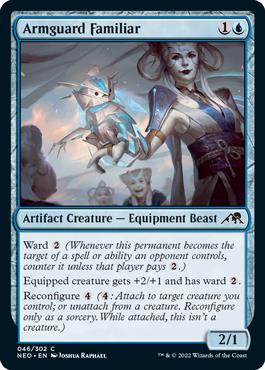
The rest of your deck can be filled up with artifact creatures and good removal spells. Izzet is the best home for mediocre artifacts like Automated Artificer, Scrapyard Steelbreaker, and Armguard Familiar since their artifact card type is very important to hit critical mass.




As for removal, the only removal spell that has the artifact subtype is Ninja's Kunai. I like this card in Izzet but also want to supplement it with cards like Kami's Flare, Voltage Surge, and Tamiyo's Compleation.
Trophy Example
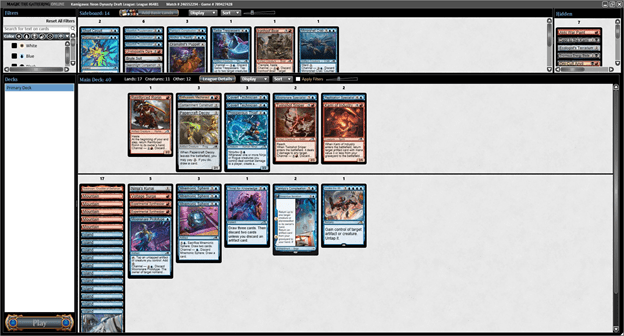
Golgari Graveyard
Of all the themes named by Wizards, Golgari () Graveyard is the theme I’m the most suspicious of. Golgari is among the least focused color pairs in the set but also has some of the most individually powerful cards, including its signpost uncommon.
Best Payoffs
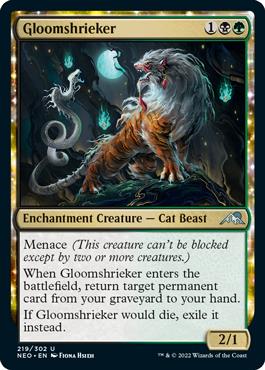
Gloomshrieker is a powerful and flexible card that proudly follows in the tradition of the iconic Eternal Witness, a card that’s still too good to print for Standard. Gloomy is the next best thing, gaining menace but being restricted to permanents and exiling itself upon death to prevent easy loops.
Even with these drawbacks it’s still a fantastic rate for Limited. Gloomshrieker is also surprisingly effective when paired with ninjas since menace makes it annoying to block and returning it to your hand is highly rewarding.
Golgari lacks an obvious linear theme because the “graveyard” theme described to us by WotC doesn’t have nearly enough support to fully build a deck around. There’s little self-mill, a few Raise Dead effects (mostly just Season of Renewal), and a few compelling reasons to really care about the graveyard. But this isn’t actually a problem for Golgari since it’s a fantastic color combination for a “good stuff” deck.

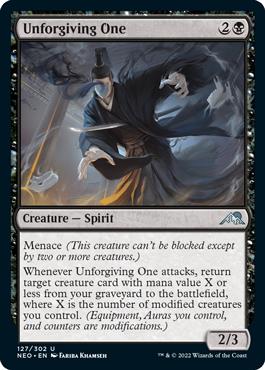
One subtheme that can occasionally be a relevant cog in the Golgari machine is modified. Black has two modified matters cards, Lethal Exploit and Unforgiving One, but lacks great ways to modify on its own. Green is the easiest solo color for this and, as I’ve said, Golgari lacks a clear identity. Fang of Shigeki also plays well with Unforgiving One since having a good disposable 1-drop makes getting value out of its trigger easier.



Another theme that occasionally comes together is Golgari Enchantments. Green is the most enchantment-dense color and black is second only to Selesnya. Enchantment payoffs like Kami of Transience, Weaver of Harmony, and Generous Visitor play great in these kinds of Golgari decks.
Useful Cards
I want to pair efficient green creatures, ramp, and fixing with black removal spells and value creatures when I play Golgari. I may also have some interest in playing a few ninjas if I have Gloomshrieker, Virus Beetle, and the like. Golgari’s approach to ninjutsu is more about generating value than tempo since there’s no Network Disruptor for the deck to play.



The best common removal spells are Twisted Embrace, Master's Rebuke, and Lethal Exploit.




Some of my favorite common creatures in Golgari are Jukai Preserver, Greater Tanuki, Virus Beetle, and Fang of Shigeki, which pairs great with Master's Rebuke and Spinning Wheel Kick.


A combination worth mentioning in Golgari is Geothermal Kami plus Twisted Embrace since the Kami can basically rebuy your Impale if you pull it off.
Trophy Example

Boros Samurai
Boros () Samurai is a cool and flavorful deck that’s one part tribal one part exalted. Of course, “exalted” is never referenced by name, but long-time Magic players will quickly see how each of the samurai cards read like exalted with extra steps. Attack alone with your samurai for powerful benefits and your opponent will soon kneel before your blade.
Best Payoffs

Asari Captain is the signpost uncommon for Boros and showcases a familiar line you’ll see a lot in Boros decks: “whenever a Samurai or Warrior you control attacks alone…” Captain itself is sadly one of the weaker signposts in the set since as it’s expensive and often finds itself or its boosted samurai getting chump blocked by tokens, Virus Beetle, and the like.
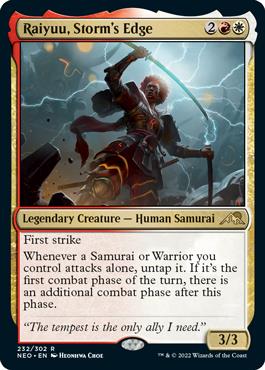
Boros Samurai isn’t a strategy I’ve personally had a lot of success with, so my recommendation is to avoid it unless you get the best incentives. The #1 card for this strategy is Raiyuu, Storm's Edge, which is good on its own but absurd in a deck built around it. It won’t take long to end a game if Raiyuu survives a couple of turns.
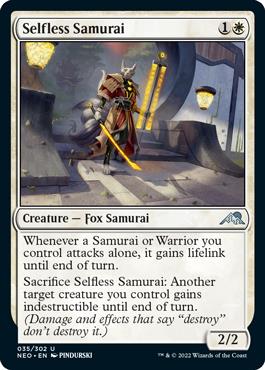
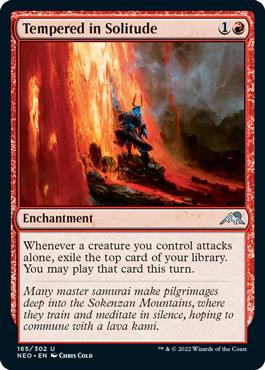
Two uncommons I love in this strategy as well are Selfless Samurai and Tempered in Solitude. One is a hyper efficient creature with a lifelink trigger and protection ability, and the other is a fantastic card advantage engine that perfectly lines up with Boros’ basic game plan.
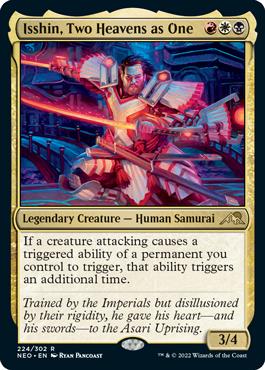
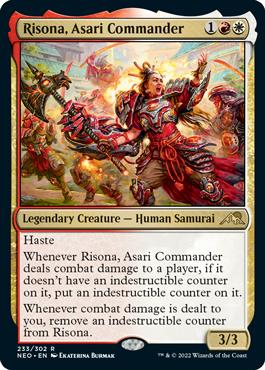
Besides Raiyuu, Isshin, Two Heavens as One (a great commander for a combat EDH build) and Risona, Asari Commander are strong, on-theme rares. Isshin is technically a black card but it’s so close enough to Boros in theme that you can consider it a Boros card that you have to splash. Doubling up exalted triggers is big game in a deck built around maximizing them.
Useful Cards




Maximizing your attacks alone game plan is best accomplished by prioritizing common payoffs for that play pattern. Peerless Samurai, Eiganjo Exemplar, Akki Ronin, and Imperial Subduer are all fine playables that an ideal Boros deck has a nice mix of. Exemplar stacks well but the others have slight diminishing returns.

Ancestral Katana is another common that I want a few copies of in every Boros deck.

Always keep in mind that your exalted triggers can proc on any warrior or samurai. One warrior that’s particularly valuable is Mothrider Patrol since evasion goes very well with exalted bonuses.

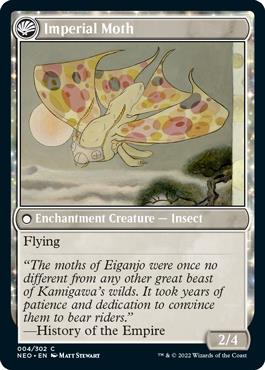

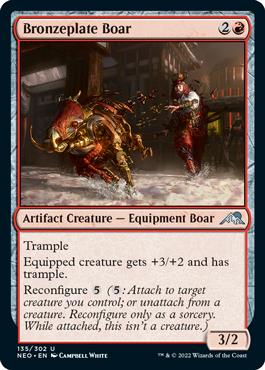
If you can’t play multiple Mothriders, consider Befriending the Moths, Ironhoof Boar, or Bronzeplate Boar as ways to get evasion. One of Boros’ weaknesses is its vulnerability to chump blocking and trample or flying directly address this.



Removal spells are also good, though I wouldn’t want a ton of them in Boros. Intercessor's Arrest, Kami's Flare, and Ninja's Kunai are ones I’ve liked. Kunai is a bit of a flavor fail but ironically plays better with samurai than ninja because the creatures you aren’t attacking with are perfectly positioned to hold your Kunai and throw it when you need them to.
One last comment I have to throw in is that I have not had any success with this deck. Seriously, I haven’t won a single trophy or even a 2-1 despite having tried Boros several times. I enjoy describing how strategies should work in theory, but in practice, don’t play this deck if you aren’t passed Raiyuu, Storm's Edge.
Trophy Example
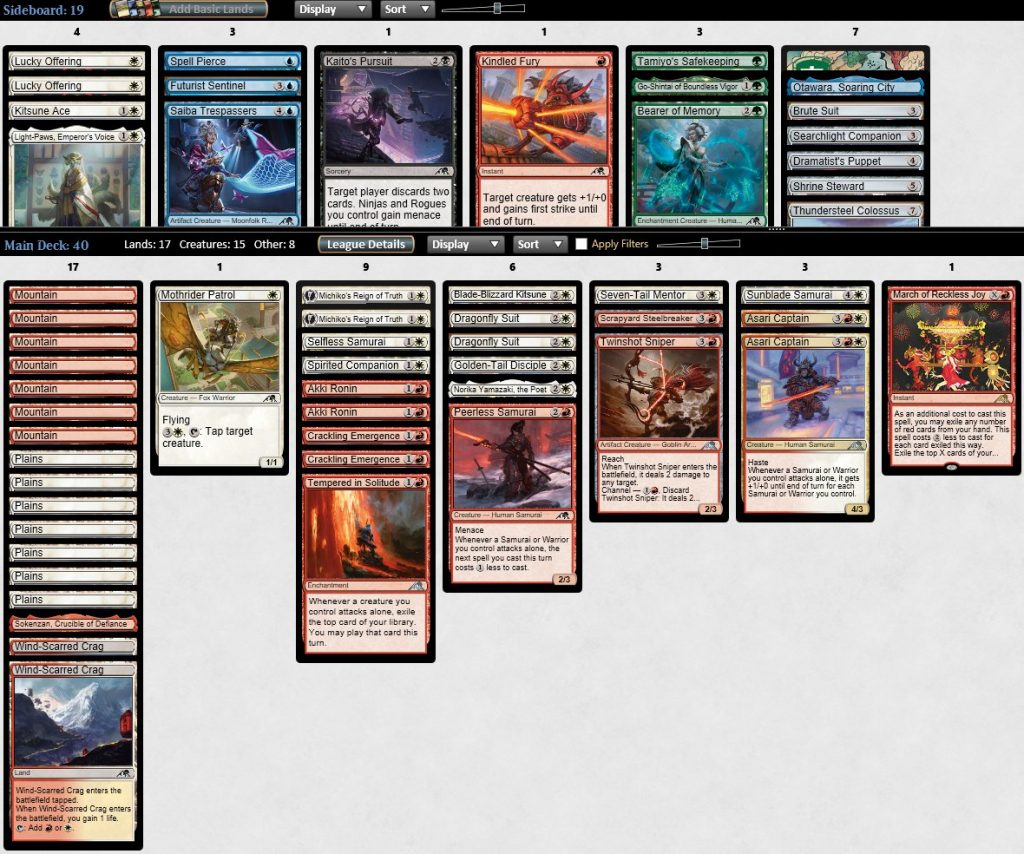
Simic Ramp
Simic Ramp is a loosely defined archetype that has nonetheless been one of my favorite 2-color pairs in the format. Simic frequently splashes powerful cards from other colors, leaning on a solid base of defensive creatures, mana ramp, and removal spells from its base colors.
Best Payoffs
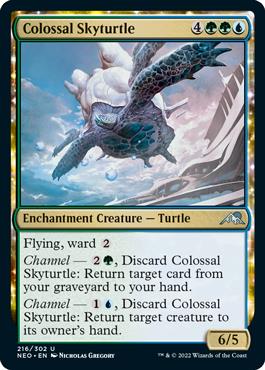
Colossal Skyturtle is the strongest signpost uncommon in the set. It’s simultaneously a Regrowth, an Unsummon, and a large flier. It also combos with Season of Renewal or Shigeki, Jukai Visionary for an easy loop: Turtle can bring them back to your hand, and then they can bring your Turtle and another card back. This can be repeated as often as you want if you can keep binning cards and your opponent eventually loses to this loop if they can’t stop you.
There aren’t many cards outside of Skyturtle that work especially well in Simic that aren’t already excellent cards. This is typical with ramp-based strategies in Limited which are always the most likely deck to splash bombs and interaction outside their base colors. Simic is no exception in Neon Dynasty, so know your bombs and play as many of them as you can!
Useful Cards
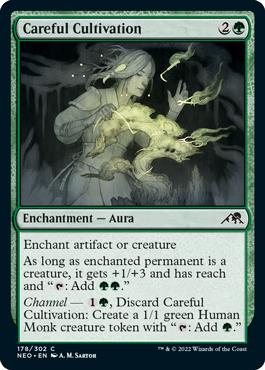
I already went over splashing bombs which heavily applies to Simic, but one ramp card that hasn’t been mentioned much yet is Careful Cultivation. I’ve liked this card a fair bit in Simic, primarily as Woodland Mystic with slight upside as a bad aura late game.



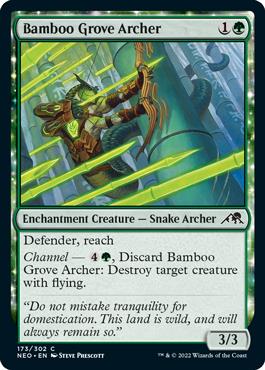
Tamiyo's Compleation, Moonsnare Specialist, Fang of Shigeki, and Bamboo Grove Archer have been some of my favorite defensive cards.

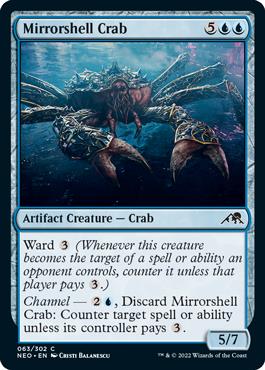


Greater Tanuki, Mirrorshell Crab, and Tales of Master Seshiro have been the best non-rare curve toppers.
Trophy Example
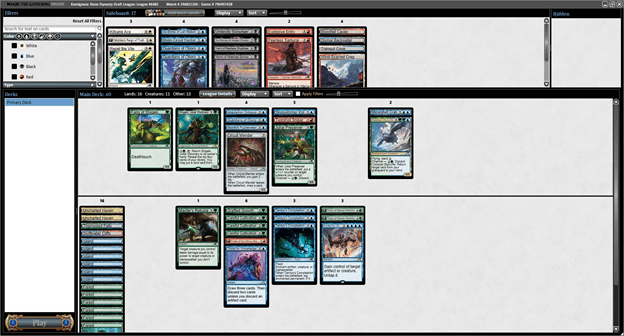
Unofficial Archetypes
Mono Red Aggro
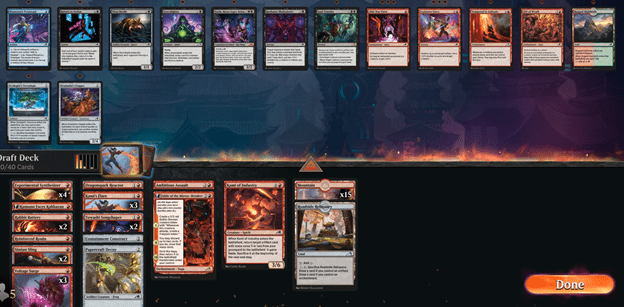
Experimental Synthesizer is a good card but it plays even better than normal in mono or nearly mono-color decks that have a low mana curve. Though you won’t see this often it is possible to build mono red in Neon Dynasty thanks to red’s viable 1-drops, card advantage, and creature density. Mono red aims to get ahead on mana efficiency with cheap creatures and red removal, leaning on Experimental Synthesizer to provide card advantage and something to do in the late game.
Grixis Artifacts
Grixis () Artifacts is a controlling deck that mixes the best of Izzet Artifacts and Rakdos Sac into one deck. This is possible for a few reasons:
- Both decks have overlapping artifact synergies and play well with a lot of the same cards, like Kami of Industry, Moonsnare Prototype, and Oni-Cult Anvil.
- There are two decent artifact-based mana fixers to tie the mana base together as well as dual lands available to make it functional.
- Red as a color falls a bit flat for control decks since aggressive cards like Ironhoof Boar, Unstoppable Ogre, and the like are poor value cards.
Izzet splash black and Rakdos splash blue fall into this umbrella, but a deck is truly Grixis Artifacts when it’s mana base is evenly split between the three colors.
5-Color Control/The Kami War
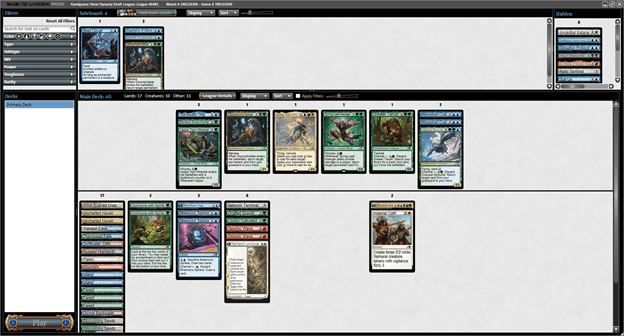
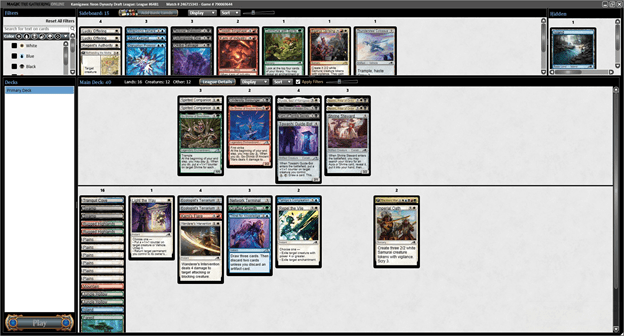
5-Color Control is a really fun and niche archetype that most closely resembles UGx Ramp, but any green base could work for this archetype. You get into this deck by opening The Kami War and deciding to draft five colors so that your 5-color super mythic is actually castable.
Pick bombs above all else since you’re 5-color and should play every single bomb you’re passed. After that you want to prioritize mana fixing, card advantage, removal, and then defensive curve filler like Bamboo Grove Archer, Jukai Preserver, and Jukai Trainee.
Wrap Up
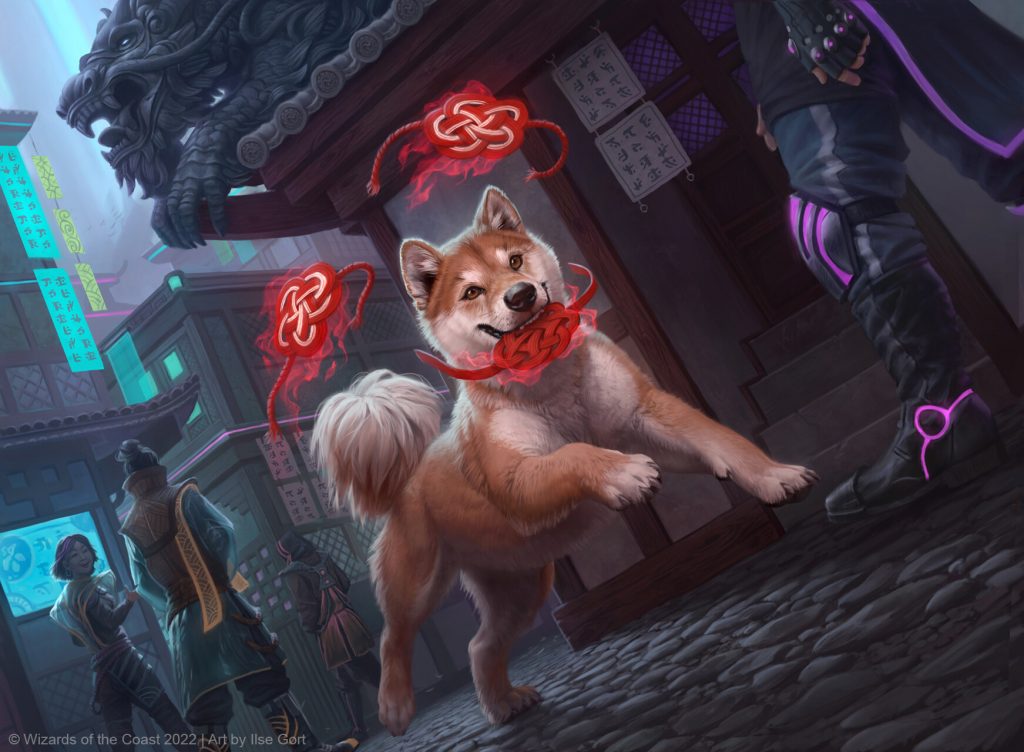
Spirited Companion | Illustration by Ilse Gort
Whew! It’s a good thing I get paid to write these otherwise I doubt I’d write so much. I love the game and all that, but love has its limits. Sometimes you’ve gotta make like a Reckoner Bankbuster and make bank, if you know what I mean. Even if you don’t, I hope you enjoyed reading this and find it useful for the Open this weekend.
What do you think of Neon Dynasty Draft so far? Do you have any stories of fun or whacky drafts? Were you able to make Boros Samurai work? Let me know in the comments down below, and don’t forget to grab Arena Tutor for your MTGA drafts. The draft helper has all my card ratings in it!
Until next time, may your Sealed pools always be stacked!
Follow Draftsim for awesome articles and set updates: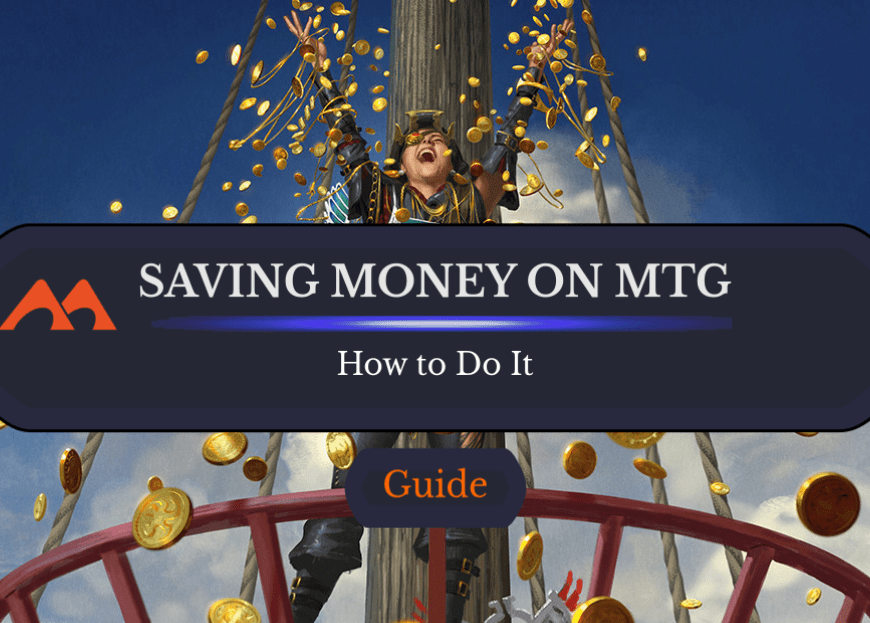

10 Comments
No luck with Boros? Asari Captain + Kiki Jiki + that guy who returns artifacts every turn and opp will concede in just a couple turns
What exactly do you mean by this? Have been trying to get boros to work with mainly kamigawa cards and it just isn’t working out, would appreciate some help
Extremely efficient combo in Azorius specially, but anything playing blue: anchor to reality (uncommon sorcery 11UU: put a vehicle from your library in the battlefield) + Thundersteel colossus (common 7 7/7 vehicle, trample haste). When played on turn 4, it’s devastating.
Second option for blue: Tameshi, Reality Architect (rare, 2U, when a card goes back to your hand draw, and X1, return a land to your hand: put an artifact with cmc X from the graveyard into the battlefield) + at least 2 Iron Apprentice (1/1 artifact for 1, comes with a 1/1 counter which can be put on any creature when it dies). Use the apprentices to block, boost and modify any other creatures on the battlefield while drawing thanks to Tameshi. Hilarious to pull out.
Many of the “Trophy Example” pictures are too small/low quality to read.
Can you please try to re-upload them?
Thanks a ton mate! I am just learning this game and this article is amazing. I hope you win the lotto soon.
Doubt I’ll be playing any lottos but glad you enjoyed it, and welcome to Magic! I write articles like this for just about every set’s Limited format so feel free to keep reading 😀
I got back into MTG Arena at the start of the year and really love playing limited. I used to only follow the Draftsim pick order lists and that led me to drafting decent decks with no synergy and very mixed results.
I started to read these draft guides over the last few months and was able to actually reach Mythic in July, a feat I never would’ve thought I could do, especially in limited!
So please keep up the awesome content! My limited decks have become much more synergistic, successful, and fun because of your articles. Take care!
Amazing, I’m so glad to hear this! Keep it up.
I read through this guide a few times before my groups Kamigawa draft this weekend. It helped me prepare and I ended up going Selesnya enchantments (normally not my favorite) and won! Thanks for sharing.
Glad to hear thank you!
Add Comment